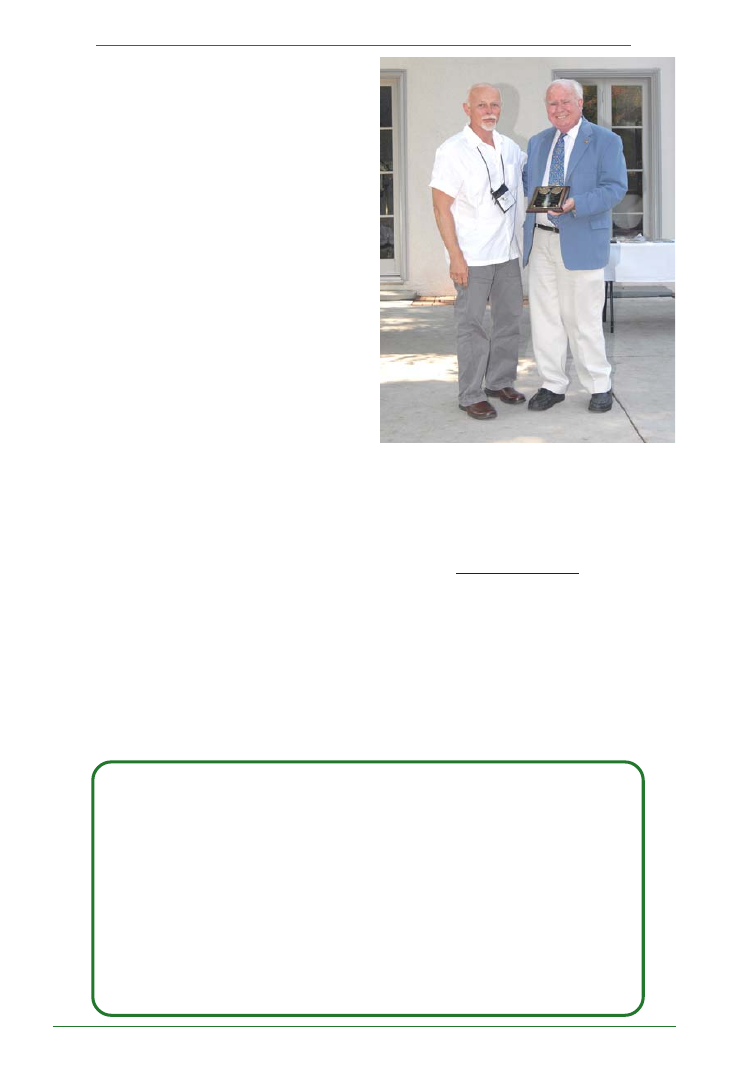
BULLETIN
WINTER 2006 VOLUME 52
NUMBER 4
PLANT SCIENCE
ISSN 0032-0919
Editor: Marshall D. Sundberg
Department of Biological Sciences
Emporia State University
1200 Commercial Street, Emporia, KS 66801-5707
Telephone: 620-341-5605 Fax: 620-341-5607
Email: psb@botany.org
The Botanical Society of America: The Society for ALL Plant Biologists
Erratum...............................................................................................................................................110
Letters to the Editor.........................................................................................................................110
The Conservatory at MUH and the 4th Grade Project...............................................................112
News from the Annual Meeting
Communicating an Awareness of Plants through Science and Art. Educational
Forum Keynote Address Roger P. Hangarter, Indiana University.................114
A Century of “Botanical Opportunity:” Building on the Past, Providing for the
Future.Presidential Address, Christopher Haufler, University of Kansas....115
The Lessons of History: A Historian Reflects on 100 Years of American
BotanyPlenary Address, Botany 2006 Vassiliki Betty Smocovitis.................120
Honoring the Past- Building for the Future. Remarks of Peter Raven during the
BSA Strategic Planning Discussion....................................................................120
Awards..............................................................................................................................123
News from the Society
BSA Science Education News and Notes....................................................................125
Editors Choice. Botany in Science Education Journals.............................................127
News from the Sections
Historical Section News and Announcements...........................................................127
Announcements
in Memoriam
A Brief Appreciation of David Lloyd...........................................................128
Marie Scott Standifer.......................................................................................129
Personalia
Award Named for Leading Crop Geneticist to go to NIH “Medicine
Man” - Gordon Cragg...............................................................................130
Timothy Motley to Old Dominion University and Norfolk Botanical
Garden..........................................................................................................130
Courses
Experience in Tropical Botany.......................................................................131
Positions Available
Assistant Professor in Plant Biology............................................................131
Partnerships for Enhancing Expertise in Taxonomy (PEET).....................132
Plant Evolutionary Genetics...........................................................................132
Award Opportunities
MORPH.............................................................................................................133
Harvard University Bullard Fellowships in Forest Research....................134
Student and Postdoctoral Opportunities in Developmental
Evolution..........................................................................................................134
Books Reviewed...............................................................................................................................135
Books Received................................................................................................................................147
Botany and Plant Biology 2007......................................................................................................148

110
Plant Science Bulletin 52(4) 2006
P
LANT
S
CIENCE
B
ULLETIN
POSTMASTER: Send address changes to:
Botanical Society of America
Business Office
P.O. Box 299
St. Louis, MO 63166-0299
E-mail: bsa-manager@botany.org
Address Editorial Matters (only) to:
Marsh Sundberg, Editor
Dept. Biol. Sci., Emporia State Univ.
1200 Commercial St.
Emporia, KS 66801-5057
Phone 620-341-5605
E-mail: psb@botany.org
ISSN 0032-0919
Published quarterly by Botanical Society of America, Inc., 4475 Castleman Avenue, St. Louis,
MO 63166-0299. The yearly subscription rate of $15 is included in the membership dues of
the Botanical Society of America, Inc. Periodical postage paid at St. Louis,MO and additional
mailing office.
With this issue we wrap up our 2006 centennial year
and look forward to a bright future for botanists. In
the News from the Society section we summarize,
or provide a transcript, of several of the major
addresses from the Centennial Meeting. We cannot
do justice to Roger Hangarter’s Keynote Address
from the Education Forum, but he provided a number
of web addresses featuring some of his spectacular
multimedia collaborations. Roger is an officer in our
sister society, the American Society of Plant
Biologists, and next year for the first time in three
decades, we will be meeting together in Chicago -
- a true congress of American botanists. In his
Presidential Address, Chris Haufler provided an
overview of botany and the Society during its long
and distinguished history and proposed a theme of
“Growing Together,” even though “It’s not easy being
green…” Peter Raven, in his opening remarks at the
discussion session on Building for the Past,
Providing for the Future, highlighted the exciting
directions for botanical research as we move into
the 21
st
century.
Each of these speakers acknowledged the critical
importance of educating the public about the
essential importance of plants in the world. There
are many ways to do this, but in our lead article we
highlight the recent success of Dan Gladish at the
Hamilton Campus of Miami University, Hamilton,
Ohio. I was excited! Imagine what might happen if
each of our campuses had a similar botanical
impact on the local community. Let’s keep that in
mind when we start thinking about “New Year’s
resolutions” for 2007.
- editor
In the previous issue Karl Niklas was inadvertantly
omitted from the list of recipients of the Centennial
Award. The following photo is proof that Karl is alive
and well and a recipient of the Centennial Award.
Karl Niklas (left) receiving Centennial Award from Peter
Raven.
Letters to the Editor
Follow-up to: Crime Solving Plants in Plant Science
Bulletin (vol. 53, no. 3). I very much enjoyed reading
the article by Shirley Graham on forensic botany in
the Fall, 2006 (vol. 52, no. 3), issue of the Plant
Science Bulletin. I whole-heartedly concur with her
assessment that specialists in key disciplines
essential to forensic botany “are relatively few in
number, and aging, and younger replacements
are increasingly rare.”
I am one of those aged, rare birds who has combined
an academic career with frequent forays into
Erratum

111
Plant Science Bulletin 52(4) 2006
Editorial Committee for Volume 52
Joanne M. Sharpe (2009)
Coastal Maine Botanical Gardens
P.O. Box 234
Boothbay ME 04537
joannesharpe@email.com
Nina L. Baghai-Riding (2010)
Division of Biological and Physical Sciences
Delta State University
Cleveland, MS 38677
nbaghai@deltastate.edu
P
LANT
S
CIENCE
B
ULLETIN
Douglas W. Darnowsk
i (2006)
Department of Biology
Indiana University Southeast
New Albany, IN 47150
ddarnowski2@ius.edu
Andrea D. Wolfe
(2007)
Department of EEOB
1735 Neil Ave., OSU
Columbus, OH 43210-1293
wolfe.205@osu.edu
Samuel Hammer (2008)
College of General Studies
Boston University
Boston, MA 02215
cladonia@bu.edu
forensic science using my professional skills in
wood anatomy and wood deterioration. Over the
past 30 years, I have been an expert witness in
murder trials, accidental injury and death cases,
other kinds of lawsuits and numerous non-litigation
wood analyses for industrial engineering firms,
pulp and paper companies, wood product
manufacturers, museums, etc. Many of these
cases have allowed me to expand my
consciousness into fields for which I previously had
only cursory knowledge. Certainly, the forensic
cases have brought me new insights into the practice
of law; and it is that aspect that I wish to expand upon
here - - as a cautionary tale for any botanists venturing
into this field.
The old saw that “you can prove anything with
[selected] statistics”, fits for lawyers who can “prove”
their case with selected evidence. I find it to be a
prudent tactic to have an initial consultation with
potential law firms prior to accepting an assignment
in order to assess whether the analysis I can
provide will be of any objective value in the case.
This lets me develop an analysis that should
withstand cross-examination scrutiny in a trial.
This approach has, for at least the past three
decades, allowed me to serve on the side that
prevails. Unfortunately, several decades ago when
forensic science was in its infancy, unscrupulous
lawyers or even government agencies could easily
distort forensic science evidence. A case that may
support this contention is the one that is the lead
example in Shirley Graham’s article - - the famous
Lindberg kidnapping case.
In January of 1981 I was contacted by attorney
Robert R. Bryan who was representing 82-year-old
Anna Hauptman, wife of Richard Bruno Hauptman
(that is the correct order of his name, despite the
reordering done by prosecution and others to
highlight his Germanic origins in the post-WWI era
of the 1930s).
Due to federal legislation, known as the Freedom of
Information Act, documents relating to the 1936 trial
that had been previously unavailable were now in
the public domain. Anna Hauptman believed that
her husband was innocent of the crime for which he
was executed, and her lawyer, in his words, was
“reviewing over 90,000 documents and other items
previously suppressed by the New Jersey State
Police.” A key piece of evidence, as noted by Shirley
Graham was the ladder left at the Lindberg home
the night of the kidnapping. Forty-five years after the
trial, this ladder was still in the possession of the
New Jersey State Police (NJSP). I agreed to analyze
all of Arthur Koehler’s documents and we hoped
that I would eventually be able to re-analyze the
ladder.
Let me first attest to Dr. Koehler’s standing as an
expert in wood structure. In the mid 1930’s Koehler
was, as I wrote in 1981, “one of the few persons
capable of doing a thorough wood analysis.” In
1924 he had published the well received text
“Properties and Uses of Wood”, (McGraw-Hill). His
very high standing in the field would have made it
difficult for Hauptman’s defense lawyers (had they
even had the resources or inclination) to find an
equally qualified expert to counter any claims made
by the prosecution. This lack of depth in the field -
- a problem facing us still - - often gives the law firm
that finds the top expert unfair advantage during a
litigation. I mention this to further bolster the remarks
made by Shirley Graham.
In going through Koehler’s documents and
testimony, I was impressed with the thoroughness
of his analysis. It is true that he sometimes
speculated beyond his data (“the board, therefore,
might have been in use for a purpose, like shelving,
in which, it did not suffer injury”). Under today’s trial
procedures, such speculation would be challenged
and might weaken the credibility of the expert
witness. However, this was not an issue in 1936
and in any case is only a minor quibble. The critical

112
Plant Science Bulletin 52(4) 2006
piece of evidence was the portion of the ladder (rail
16) that Koehler eventually matched to a sawn out
board from the attic in Hauptman’s house. A key bit
of information that is left out of the many stories
written about Koehler’s analysis of the ladder is the
time scale. Yes Koehler may have “alerted
authorities to look for a missing board”, but the
N.J.S.P. had been in possession of the ladder since
the kidnapping, and they had searched Richard
Hauptman’s house and garage several times prior
to his arrest. At any of those times, they could have
taken a board and “doctored” the ladder.
During the investigation, the N.J.S.P. refused to
share any information with the F.B.I. (too long a story
to delve into). An F.B.I. document of May 26, 1936
(reportedly withheld from the court proceedings)
stated “The identification of the wood in the ladder,
resulting in the opinion that the wood in the attic of
Hauptman’s residence was identical with that of the
ladder was developed subsequent to the withdrawal
of the Bureau from an active part in the investigation
and occurred after the New Jersey State Police had
rented the Hauptman residence.” Even before the
rental, the house and garage “had been searched
at least nine previous times.”
Koehler also testified that “a comparatively dull
plane” had been used on rail 16 and two rungs. A
N.J.S.P. officer “discovered” the dull plane to match
the marks on the boards on a shelf in Hauptman’s
garage.
Some bits of evidence don’t square with Hauptman
being the maker of the ladder. Richard Hauptman
was a skilled carpenter. In fact, he had cabinetmaker
skills as evidenced by a custom wooden trunk he
had built for his car. Yet, Dr. Koehler wrote in his
report “the construction of the ladder in general is
very crude, showing poor judgement in the selection
of the lumber and in the design of the ladder, and
poor workmanship. For a job that was to pull down
$50,000, [the ransom demand] it showed poor
foresight.” Another logical question one might ask
is why would a carpenter go to his attic and rip up and
saw out a floor board to make a ladder. He clearly
would have plenty of easier ways of getting some
wood. I could elaborate on the many other aspects
of the investigation and trial that would fail to meet
judicial standards of today, but since these don’t
relate to the ladder, I will forego that discourse.
In the end, although I was permitted to revisit the
N.J.S.P. headquarters, and saw the famed ladder,
I was not allowed to do any forensic analysis, and,
therefore, withdrew from the case. So, despite the
books and T.V. documentaries that have argued the
probable innocence of Hauptman, we will likely
never know the truth of his guilt or innocence. The
caution here is that the ladder evidence in the
Lindberg case, or any other trial evidence, can be
cleverly used or misused, to tip the scales of justice
for good or ill purpose.
In the Hauptman case, the press and public had
already convicted him before he entered the “show”
trial of the century. So, in real life, not all cases are
neat and tidy as portrayed on CSI or other TV
dramas. Nevertheless, forensic science has proven
to be a fascinating part of my career in botany, and
one I plan to continue upon my University retirement.
-Richard Jagels, Professor of Forest Biology,
University of Maine
The Conservatory at MUH and the
4th Grade Project
The Hamilton (Ohio) Campus of Miami University
(MUH) recently celebrated the first anniversary of
the opening of its botanical conservatory. In
celebration of this, it seemed appropriate to share
with members of the Botanical Society of America
our excitement about this “growing” success, and
how we are using this opportunity to increase
interest in plants and the plant sciences in our
region, especially for students of all ages.
The initial idea for a “Plant Collection Center” to be
used by students in botany classes at Miami
University and as a resource for K-12 education
was proposed by me in 2002 as part of a capital
improvements campaign.
A Hamilton
businessman and philanthropist, Richard Fitton,
and his wife, Rebecca, showed an interest in
supporting the project, but indicated that they thought
the idea was too modest. An expanded concept
was developed and approved by MUH staff and
administrators.
The Conservatory
Beginning in 2003, a series of meetings involving
architects, contractors, MUH administrators, the
donors, and myself resulted in plans for a much
expanded and architecturally distinctive structure,
large-scale artwork, formal gardens, a grove of
native trees, and expansion of and improved trails
for our pre-existing demonstration tallgrass prairie
“garden,” which was planted by volunteers in Spring
of 2001. The Fitton family ultimately agreed to
donate $3.65 million for the project, which also
included an operational endowment and funds for
a graduate assistantship. Mr. Fitton requested that
it be named simply “The Conservatory.” The Miami
University Board of Trustees gave final approval in
April, 2004. The groundbreaking was Sept. 1, 2004.
Construction was completed in mid-September,
2005, and landscaping around The Conservatory

113
Plant Science Bulletin 52(4) 2006
began. Most unfortunately, Mr. Fitton did not live to
even see the groundbreaking.
In the meantime, Dr. Richard H. Munson was hired
as Manager of The Conservatory in September,
2004. Together we planned the acquisition and
layout of our collection of exotic plants and gardens,
and, once the climate control systems were
functional, we began acquiring plants. Because
we had only 2.5 wk before the dedication ceremony,
we took advantage of every commercial retail and
wholesale dealers of exotic plants (especially
Tropical Foliage, Inc. and Tristate Foliage, Inc.) in
the Cincinnati area to get our initial specimens.
Most of these were interesting plants of good quality.
Later, when events began to proceed at a more
sane pace, we acquired plants as gifts from our
good friends at Krohn Conservatory in Cincinnati,
from Bill Hendricks at Klyn Nursery in Perry, OH, and
from Tim Metcalf and Ernesto Sandoval at the
Botanical Conservatory of the University of California
at Davis (my Alma Mater), who have been especially
generous. We also purchased a number of plants
from the Glasshouse Works in Stewart, Ohio. Our
students, colleagues, and volunteers have brought
plants and seeds to us, notably from the State of
Florida, Puerto Rico, India, and Gabon.
The Conservatory has seven “zones” for its
collection. Externally we have display gardens,
including a plaza with formal gardens (which
currently are planted with 60% native plants or their
cultivars), a herb garden, and a vegetable garden.
We also have the aforementioned prairie (all-native
to Ohio except for the weeds), and the nascent
native tree grove with many specimens yet to be
planted (we are growing many of them from seed).
The Conservatory structure itself is about 7000 ft
2
with 5200 ft
2
under glass. There is an atrium where
our large, arborescent specimens are displayed, a
tropical room, a desert room, and a “horticulture”
room for cultivars and hybrids. A separate service
wing is devoted to research, instruction, propagation,
and student class projects. We also have a meeting
room that can seat 30 and a headhouse that contains
workspace, office space, equipment such as boilers
and a reverse-osmosis water purification system,
and our computerized climate control system.
Currently the doors are only open to the public a total
of 18 h/wk, but we hope to expand those hours soon
as our volunteer group grows. On the other hand,
we give guided tours to school classes and civic
groups by appointment. In addition to visits by our
various biology classes, faculty of art, photography,
and writing classes are taking advantage of the
facility. We are most proud of the relationship with
have begun with the Hamilton City School District,
which includes our new 4th Grade Program.
The 4th Grade Program
An examination of the Ohio State Science Standards
revealed a surprising fact: the only grade in which
plant biology is featured specifically is the 4th.
Although this was pretty disappointing, we decided
to “make lemonade” by developing curriculum for
the 4th grade. Prof. Elisabeth Schussler, who has
written articles for Plant Science Bulletin and other
periodicals on the subject of “plant blindness” (the
widespread problem in our society of being unaware
of plants in general and their importance in the
environment), is now a member of the Miami
University Botany Department. She joined us in this
important effort to raise awareness about plants in
children.
The program initially involves six Hamilton
elementary schools and will be expanded pending
assessment of the outcomes. It has a classroom
component managed by the classroom teacher, a
laboratory component managed by the District’s
Science Specialist, Terry White, and a conservatory
component managed by me. Beth Schussler made
sure that each component addressed the state
standards specifically so that teachers would be
attracted to the program despite the current political
climate, which emphasizes testing and
“accountability” in a punitive way.
The classroom component focuses on plant growth,
plant reproduction, and the scientific method and
takes advantage of a commercial product from
Carolina Biological Supply Co., the “Plant Light
House™” and Brassica rapa cv. ‘Wisconsin Fast
Plant
®”
as the subject plant material. Each
classroom in the initial program received a complete
“lighthouse.” Each “lighthouse” is a white plastic
chamber, 42x42x52 cm in size, with one open face.
Each is equipped with a compact fluorescent lamp
whose height can be adjusted. In each chamber
are two water reservoirs that provide moisture by
capillary action for 16 small plant growth cells

114
Plant Science Bulletin 52(4) 2006
containing conventional potting soil and one Fast
Plant. Each classroom also received deceased
bees and applicator sticks from which the students
fashion “bee sticks” for manually pollinating half of
their plants. The students will later evaluate the
effectiveness of their pollination efforts by counting
fruits and seeds from the two groups of plants. The
teachers will take this opportunity to discuss
scientific method. In addition to the above, which
was sponsored by the office of Barbara Fuerbacher,
the Assistant Superintendent of Schools, I provided
basic information about plant morphology that the
students could use while examining their plants
and flowers.
After the children had been working with their
“lighthouse” plants for a while and have had a
chance to observe their plants growing and flowering
and to learn some morphology in the classroom,
they will visit the MUH Campus for a day for the other
two program components. Upon arrival at MUH the
students are to be divided into two groups. One
group goes to a plant biology teaching laboratory
where Terry White guides them through the
dissection of flowers with an accompanying
discussion of plant reproduction and the mutualistic
role of pollinators. The other group goes to The
Conservatory for the “Plant Treasure Hunt Game”
where they exercise their descriptive powers and
communication skills.
Before the game starts, there is a free question
session. Then the students choose partners. Each
student gets a writing tablet and pencil and is invited
to choose one of the collection rooms in The
Conservatory (different than her/his partner), to find
an interesting plant in that room, and to write a
detailed description of the plant using botanical
nomenclature as much as possible - but omitting
the name, of course. They then trade papers with
their partners and search their partner’s room to try
to find the respective plants. If they have difficulty
they may consult with their teacher or me, or they
may ask their partner to provide more information.
When they think they have found their mystery plants,
they consult their teacher or me and write down the
binomial on the description and get it initialed by the
adult. The partners then choose another room and
go through the process again. The team with the
most plants correctly identified at the end of the
approximately one hour period wins the game, but
everyone gets a sticker with The Conservatory logo
that says, “I hunted exotic plants at MUH,” their
notepad, which likewise has our logo on it, and a
packet of Ohio native prairie wildflower seeds, so
everyone is a winner.
We did this for the first time this past Tuesday,
October 10th. It was a huge success. The children
were very excited about every aspect of the day. I
was bombarded with questions the entire time.
The winning teams in the treasure hunt correctly
identified 12 and 15 plants, respectively ... and we
had enough time left in the day to go for an “explore”
in the tallgrass prairie afterwards, where they began
to satisfy what appeared to be an insatiable curiosity
about spiders. It was a day to be remembered by
all of us. I hope I shall have recovered sufficiently by
this coming Tuesday to take on another group of 40-
50 nine-year-olds. Furthermore, I can tell you that
my respect for elementary school teachers has
been thoroughly renewed.
By Daniel K. Gladish, Assoc. Professor of Botany
and Director of The Conservatory
News from the Annual Meeting
Communicating an Awareness of
Plants through Science and Art
Education Forum Keynote Address
Roger P. Hangarter, Indiana University.
“This is how I used to teach phototropism in plant
physiology” (A traditional lecture and demonstration
lab). So began Roger Hangarter’s forum address
on the evolution of “sLowlife,” his award-winning
multimedia presentation that opened at the National
Botanical Garden in October, 2005 and ran through
March, 2006 (it will be in Chicago in 2007).
www.slowlife-exhibit.org
What changed the way he
teaches is when he took his Webcam, originally
used for research on tropisms, and “turned it on the
students.” His students had “absolute total
amazement that plants move!” Hangarter asserts
that this shouldn’t be such a great surprise for
students. After all, in Lord or the Rings, Tolkein
created talking, moving trees, the ENTS, that
behaved like perfectly sensible individuals - -
providing you observed them following their maxim
– “Don’t be hasty!” The key to filming plants is “You
have to watch the plants and know what they do
before you start filming.”
Hangarter’s original black and white time-lapse
videos formed the core of his fascinating “Plants in
Motion” web page
http://www.bio.indiana.edu/
~hangarterlab
/. Today, students make similar images
of their own as class data and digitally analyze the
motion they observe. The images on Hangarter’s
page are downloadable and may be used in your own
Power Point presentations for classes!
Originally this web page was set up for students, but
Hangarter also began receiving emails from artists,
including Dennis DeHart, an artist on the faculty of
the State University of New York at Buffalo. The
seeds of “sLowlife” were planted!

115
Plant Science Bulletin 52(4) 2006
.
According to Hangarter, the “sLowlife” exhibit was
designed to be “an exercise in subliminal education”
demonstrating first, that plants are alive, and second
that plants respond to stimuli. Upon entering the
exhibit, visitors are confronted by a screen with 101
panels of Arabidopsis plantlets, about 10% of which
are in motion at any one time. Random panels are
periodically replaced by graphs of published data
describing the movements - - a new kind of “abstract
art.” This introduction may be subtitled “twist and
shout” (be sure to check Hangarter’s web page to
see what the Science Museum of Minnesota did
with images of these “dancing plants!”)
Visitors are next confronted by a panel of classical
still life paintings – an artistic favorite because, as
the artist Georgia O’Keefe noted, “plants don’t move.”
But what? The cut tulips in the center start to move!!
Hangarter also worked with the IU music department
to compose an appropriate sound track. Specific
tones were assigned to data from actual research
spread sheets describing the plant movements.
The resulting score accompanies the video image.
Phototropism in corn is the subject of the “Sensing
and Responding” panel. Here the exhibit pays
tribute to Darwin’s The Power of Movement in Plants
with diagrams and explanation of how Darwin plotted
the nutation movements of growing scarlet bean
plants. (Hangarter suggested that morning glories
work very well for students trying to replicate Darwin’s
work).
In the section on “Orchestrating”, timelapse photos
are used to illustrate the complete lifecycle of
Arabidopsis from seed to seed. For
“Microprocessing” tobacco cells are used to
illustrate ultrastructural movements associated with
cell division. “Unseen Acts” shows the growth of
roots, both elongation and branching, through agar
medium, and “The Power of Plants” uses contributed
still images to represent what “power of plants”
means to different artists.
Finally, “Photosynthesis” is a memorial to how
plants “concentrate all that dilute stuff - - CO
2
.”
Standing on a pedestal in a classical Greek temple
is a flask of chlorophyll extract, illuminated by
fiberoptic light and fluorescing red. The effect is an
artistically striking composition with an underlying
message of the significance of plants for life on
earth.
As an encore, Hangarter presented the short web
version of his award-winning movie on the 2004
episode of the 17-year Cicada cycle. (A botanist –
produced and filmed documentary funded in part by
an NSF grant to another botanist – Keith Clay!) This
clip is also available on the Hangarter web page.
For a brief biography of Roger Hangarter
, see http://
www.2006.botanyconference.org/EducationalForum/
Roger.php
-Marsh Sundberg
A Century of “Botanical
Opportunity:” Building on the Past,
Providing for the Future
Presidential Address
Christopher Haufler, University of Kansas
As I was pondering appropriate words to accompany
this evening’s festivities, I thought back over the
time that I have been attending Botany Banquets,
and realized that I have been present for about one-
third of the 100. Thinking back over the more than
30 banquet addresses that I have enjoyed, I found
that they could be placed into three overlapping
categories: Reviews, Overviews, and Previews.
Reviews generally provide a historical perspective
on a topic or event or field – how we reached the state
of understanding that we have. Overviews develop
a set of commentaries and contemporary
understandings of a field – they provide us with a
snapshot of a discipline or they place a field into
context with a discussion of the latest findings.
Previews generate ideas for the future and make
forecasts for the course of our science. Some
recent examples illustrate the different kinds of
addresses to which we have been treated. For his
banquet address in 1986, Ray Evert delivered a
review of the life and contributions to science and
education that Kathryn Esau made. In 1998, Carol
Baskin reviewed the 30 years of meetings she had
attended, the fun she had at meetings, and the new
perceptions, knowledge, and friends she had
gained in the process. In 1999, Doug Soltis gave an
overview of the enormous impact that DNA
sequencing had made on understanding plant
phylogeny, and emphasized the distinct teamwork
approach taken by botanists in developing and
analyzing these data bases. In 2002, Scott Russell
gave an overview of both the state of the BSA and of
his explorations of sexual reproduction in plants. In.
2003, Linda Graham showcased vertical studies of
two liverwort species and gave a preview of how we
should be considering the way that organisms can
be used as the focal point for bringing different
methods to bear on a series of open questions,
from the molecular to the ecological level. At the
2004 meetings, Alison Snow suggested ways that
botanical topics can be promoted in the popular
press, and showed how the public can be made

116
Plant Science Bulletin 52(4) 2006
aware of the progress of research and education
involving plants.
But has this been the pattern since the origin of the
Botanical Society? To discover what the founders
presented after their banquets, I consulted the
archives. Probably to no one’s surprise, what I
discovered is that even my most distant
predecessors also offered Reviews, Overviews,
and Previews. Originally, it was the retiring president
who gave the banquet address, and some of these
provide fascinating glimpses of the state of science
and the society at the time. They also demonstrate
how little we have progressed, and yield some
clear perceptions of the personalities of our founding
fathers (and they were all fathers – the first woman
president of the BSA was Margaret Clay Ferguson
in 1929). For a review, we can look at the address
that Lucien Underwood gave after the second BSA
banquet. Underwood reviewed “The Last Quarter
– a reminiscence and an outlook”. Using strong
language (that seemed to be his trademark),
Underwood emphasized how far the science of
botany had come in 25 years. At the same time that
his remarks are historically valuable, the realization
that little has changed over the past 100 years can
be quite depressing. Consider Underwood’s
observation that at the end of the 19
th
century,
“Evolution was some unholy doctrine about
monkeys that contradicted the bible.” Sounds
scarily familiar today, doesn’t it! He also noted that,
“scarcely anyone looked at botany as a serious
subject.” It was “a harmless elective at misses’
boarding schools.” What Underwood was reviewing
at the start of the 20
th
century has returned as a
feature at the start of the 21
st
century. History does
repeat itself, perhaps especially in science.
As an example of an overview, consider that of
Robert Harper, a professor at the University of
Wisconsin whose specialty was the study of
coenobic algae. In particular, he focused on the
development of the cellular network in the genus
Hydrodictyon. Developmental processes were
debated and the hypothesis of preformation and
epigenesis were still in vogue. While acknowledging
that what appears to be demonstrated by these
algae may not hold in more complex organisms, he
showed that regeneration of the growth form of the
algae did not require one to assume pre-formed
organization in the egg.
The preview I will feature is the very first Botany
Banquet address, given by retiring president William
Trelease. This address provides perspectives on
the origins of the BSA and shows both how little has
changed and how far we have come in the past
century. In his address, Dr. Trelease sought to
reach out to “the large and growing number of
young botanists who may be expected to look to this
society for a certain amount of help and inspiration,”
and I would like to do the same this evening.
In expanding his topic of “opportunity,” Dr. Trelease
divided his comments to focus on opportunities for
institutions and opportunities for individuals. The
rule at this point in history appeared to be that
colleges and universities were primarily places of
learning, not research, and museums and botanical
gardens focused on displays rather than discovery.
Trelease predicted that, “we have before our eyes
the spectacle of a gradually unfolding class of
institutions in which investigation is not only tolerated
but expected.” He noted, however, that to provide the
opportunity necessary to generate an atmosphere
conducive to research, investment in equipment
would be necessary. Although many institutions
had equipment devoted to helping students learn,
more specialized instruments were necessary to
generate opportunities for innovative research.
Trelease also recognized that the nature of scientific
equipment was changing saying that equipment for
research experimentation “should be regarded as
transient, perishable material.” This seems pretty
forward thinking for the time, and it certainly holds
true today.
In his address, Dr. Trelease provided perspectives
on the resources available to promote research in
botany, and suggested what future progress was
likely. Even at that time, Trelease found it necessary
to compare basic and applied science, and show
how studies in fields such as botany relate to more
marketable enterprises. He said, “nearly every
great manufacturing or commercial advance has
grown out of a succession of obscure discoveries
made by the devotee to pure science.” Another
important “opportunity” that Trelease identified was
the herbarium, as well as the capacity to invest in
living collections to provide researchers who
anticipate working with plants. Wisely, Trelease
recognized that living collections could only be
modest in size and transient, devoted to a particular
project for a defined amount of time. Coordinated
with the availability of living collections, Trelease
opined that research institutions will need to provide,
“very liberal opportunities for its staff to visit even
distant regions for the study, in their native homes,
of plants which cannot be cultivated.”
Addressing the individual, Trelease thought that
researchers should be broadly trained, and should
use that broad foundation as a basis for thoughtful
specialization. To the students in the audience, he
stressed the value of comprehensive training across
the sciences. Trelease emphasized that, “the
student cannot afford to devote more than about
one-half of his undergraduate time to a single study
like botany.” He noted such training should provide
“for a lifetime of more or less uninterrupted

117
Plant Science Bulletin 52(4) 2006
opportunity for unearthing the wealth of discovery.”
Despite recommending broad training, even a
century ago, he saw that the expanding wealth of
information could be debilitating, and individual
research agendas needed to be focused and
narrow. He also emphasized that a brick-by-brick
approach to building the research edifice was more
profitable and successful than trying to discern the
next great breakthrough and hoping for giant leaps
of research progress.
Summarizing what Trelease saw as botanical
opportunity as the Botanical Society of America was
launched, he stressed the need for institutions
whose main mission was research. In such places,
facilities to produce and house specialized
equipment for modern research would be provided,
and funds would be available to support research
efforts, including both field and laboratory
components. Trelease also saw a great need for
training new generations of botanists. He
emphasized that the best scholars were those that
were broadly trained and who were taught to think
critically. He saw that one of the best ways to foster
the kind of learning that would result in excellent
new botanical researchers was for current
researchers to bring their expertise into the
classroom. Clearly Dr. Trelease made good sense
and his view of the future was insightful and forward
thinking.
One of the elements that Trelease did not see was
the impact that breakthroughs in research
technology and analytical methods would have on
shifting the direction of knowledge accumulation.
He was correct in thinking that in biology the
availability of dramatically different new questions
was not likely, but burgeoning new techniques that
allowed different approaches to answering those
questions did keep changing the way that knowledge
accumulated, and provided often dramatic new
answers to old questions.
Trelease also missed how the explosion of new
research institutions would promote increasing
specialization in plant research. As more and more
different ways to approach the study plants were
discovered, it was no longer possible to establish
a comprehensive understanding of botany writ large.
In fact, a prominent element of scientific progress
during the 20
th
century was the disintegration of
botany. The amalgamation of fields and societies
that became the Botanical Society of America a
century ago (including the Society for Plant
Morphology and Physiology and the American
Mycological Society) demonstrated early on that
there were different perspectives and approaches
to the study of plants. What began as a joining of
forces to provide a united force for the future did not
last.
When the BSA was founded, degrees at major
institutions were offered in Botany, Zoology, and
Microbiology (then called Bacteriology). With an
increase in the number of research scientists,
knowledge about the biological world expanded.
However, as the accumulation of data exploded, so
did the field of botany. More and more groups
splintered from the original BSA, and that trend
continues. Today, accepted fields in biology include
cellular, molecular, developmental, genetical,
evolutionary, ecological, and other disciplines: at
the same time, degrees in botany have become
rare.
A second trend that pervades the first century of the
BSA is the search for the “magic bullet,” the ultimate
technique that will provide answers to life’s
persistent questions. Beginning with the
visualization of chromosomes and the study of
meiotic behavior, chromatography and
electrophoresis allowed biologists to study the
micro and macro molecular composition of plants.
Today’s reigning “magic bullet” is nucleic acid
sequencing. The emergence of these techniques
spawned new disciplines as well – how many
Departments of Molecular Biology do we have in the
country today, departments that are based on a
technique, not a discipline or a set of organisms?
This trend can have the adverse effect of changing
biologists into technicians rather than allowing
them to be creative scholars. Fortunately, institutions
that have protected a more whole-organism
approach have thereby maintained a focus on
“question” oriented approaches to research.
Part of the problem that botany has faced relates to
the organisms themselves. Plants do not have soft
fur and big brown eyes, and (except for carnivorous
plants) lack the “oh, gee, wow!” factor that many
animals possess. Thus, botany has always
attracted fewer undergraduate majors than Zoology.
Even at the level of public awareness, our neighbors
are simply less well informed about the
sophisticated science that botanists perform. When
someone says “botany,” the regular reaction is to
see a hobbyist who identifies wild flowers rather
than a serious research scientist. Zoology is a
much “cooler” topic; even the most renowned
botanists are often seen as the “nerd” scientists,
and are not accorded the same prestige as
scientists who work on animals.
As the 20
th
century progressed, botany faded as an
acceptable field at major research institutions.
Looking back at the early part of the 20
th
century,
botany was one of the primary subjects that attracted
students to biology. But by the middle of the century,
botany began to disappear as an undergraduate

118
Plant Science Bulletin 52(4) 2006
major and an academic department. To be fair, so
did Zoology. Biologists currently in control of
disciplinary nomenclature appear more comfortable
tied to disciplines such as biochemistry, genetics,
ecology, or systematics than focusing on any one
set of organisms.
For much of the 20
th
Century, the BSA tracked the
fortunes of the field of botany, building strength
through the middle of the 20
th
century, and showing
disturbing plunges in membership in the 1970s. In
the last 20 years of the century, as more and more
fragmentation and splintering of biology continued,
the BSA has assumed a role as a coordinator of
botanical research and teaching. By pulling together
national and international botanical endeavors, the
BSA retained lost momentum, rechanneled its
outreach and synthesis efforts, and emerged more
stable and ready for the new millennium.
At the start of the 21
st
century, biology continued its
headlong charge toward greater specialization, and
there is even more pressure for coordination and
integration. Consider just one topic, specializing on
the cellular details of plants. My survey indicated
that there are now at least five professional journals
that seek research publications on the study of plant
cells: (1) Plant cell, (2) Plant, cell and environment,
(3) Plant cell reports, (4) Plant and Cell Physiology,
and (5) Plant cell, tissue and organ culture. I’m not
trying to pick on those who study the plant cell, but
there seems to be more call than ever for the BSA
to continue and expand its role as an umbrella
society dedicated to keeping the focus on the forest,
even though the number of trees just keeps getting
larger.
In the last section of my address, I will develop some
observations and suggestions on ways that botany
and botanists might adapt to the future. Given my
emphasis so far on the culture of biology and our
society, I will comment on two general aspects of
research and make some observations about the
role that plants may be able to play in education.
My comments so far have emphasized general
trends in the way that botany and the study of plants
have changed through the last century, and the
observations and suggestions I will make are
similarly broad. Focusing first on research trends,
I’d like to think we have disintegrated biology far
enough and it would be best if we could find more
and better ways to generate more integration.
Toward this end, botanists could promote the
organism as an organizing principle in achieving
integration of the many and varied lines of evidence
that have developed. In part, of course, this is an
ongoing activity. Whenever we revise our hypotheses
about the trajectory of morphological change in
response to new insights from DNA sequence
data, we are coordinating these two lines of inquiry.
But it seems to me that we could expand the extent
of this coordination by placing the whole organism
at the center and capitalizing on the ways that
organisms contain and connect the many
approaches and lines of evidence that have been
accumulated.
Consider, as a “random” example, a fern. Its
distinctly different life history stages (gametophyte
and sporophyte) compartmentalize different
aspects of the physiology, development, and
reproductive biology of the species and allow these
perspectives and processes to be integrated in
providing a full picture of the organism. Considering
the whole organism can also provide links between
ecological pressures that yield adaptational change
and systematic perspectives on the history of the
species. From these studies emerges a well-
explicated and integrated view that knits together
the many specialized components, from genetics
and cellular details to ecological responses and
phylogeny. Such an integration demonstrates well
how the component approaches benefit from
shared knowledge, e.g., how an understanding of
phylogenetic relationships can help to interpret
apparent adaptations and put physiological features
and developmental stages into historical context.
Turning from “vertical” integration across different
elements of an organism to “horizontal” integration
within a discipline, it would appear that some
disciplines lend themselves particularly well to
bringing together contributions from disparate
sources. Consider development. This discipline
focuses on the transmission and expression of
information from its source in DNA to its ultimate
display as a fully functional organism. No wonder
that developmental biologists consider themselves
as geneticists as well. Integration of this kind is vital
if we are to understand and explain how organisms
are more than just a sum of their parts.
In a similar way, evolution is also a remarkably
integrative discipline, encompassing studies at the
nucleotide level, the individual, the population, the
species, and, ultimately the classification of life on
earth. But very few (if any) evolutionary biologists are
able to integrate the full reach of evolution, and once
again I recommend that we consider ways to take
advantage of the breadth of disciplines like evolution
to develop more fully rounded views of the natural
world.
To achieve this level of integration will, I think,
require a new level of cooperation, reaching across
borders that have resulted from the specialization
of biology into pigeonholes that have canalized our
field and put blinders on individual workers.
Fortunately, some efforts to reverse this trend are

119
Plant Science Bulletin 52(4) 2006
already in place. Over the next three years, the BSA
will be meeting with sister societies and thus providing
opportunities to break down walls that have challenged
cooperative endeavors. In 2007, we will meet with the
American Society of Plant Biologists, in 2008 with the
Canadian Botanical Association/L’association
Botanique du Canada, and in 2009 with the Mycological
Society of America. We should capitalize on these all
too rare opportunities for building bridges and
cooperative endeavors. Sponsoring cross-cutting
symposia would be a first step. In planning for our
meetings, we should also continue to reach out to
other professional societies and seek opportunities to
meet with them.
Throughout the history of the science of botany, the
most innovative progress has been made by
individuals capable of sitting on the interface between
two major disciplines. Two that come to mind as
representing the wave of the future are Evolutionary
Developmental Botany, or Evo-Devo, and the study
of Plant Speciation. Both of these interdisciplinary
fields demands attention across fields, and
develops hypotheses that require the investigator
to be broadly trained. In the case of evo-devo,
investigators are using new methods of tracing the
developmental pathways that give rise to
morphological features and then showing how the
control of these pathways provide insights on often
very deep relationships between major lineages.
The process of speciation, meanwhile, requires
that the investigator make connections between the
ecology of populations and the genes controlling
change. Studies of how new lineages are initiated
requires the investigator to study both the internal
genetic constraints and the environmental
pressures that influence change. Breakthroughs in
either evo-devo or speciation will lead to novel
insights in a broad range of major fields, and I’m
sure there are other such interdisciplinary fields
that are only beginning to emerge.
Turning briefly to our responsibilities and
opportunities in education, we live in precarious
times. Unfortunately, the emphasis on research
that Trelease and others saw as important to advance
science has had the side effect of diverting our most
creative thoughts and a majority of our time in
pondering the next frontier in our disciplines. As a
result, we neglected education and have generated
too many generations of scientifically illiterate
citizens. Time does not permit me to explore the
origin and evolution of this very real and potentially
disastrous problem, but it seems clear that in the
future we must divert more of our time and energy
into helping the public understand what science is,
how it differs from belief systems, and why it is so
important as we advance into the 21
st
century. The
good news is that both commercial and individual
efforts are being made to develop plant tools that
can be used to provide students with a solid
understanding of science as a process. Especially
as issues of using animals experimentally remove
them as appropriate models in teaching, plants
emerge as ideal organisms whose biology allows
exploration of questions about physiology,
biochemistry, genetics, development, ecology,
evolution, etc. Members of the BSA should turn
some of their attention to developing laboratory
teaching activities that exploit the unique features of
plants for instructional purposes. Members of the
BSA are in the best position to know what elements
of science can be demonstrated most appropriately
by plants. We are the ones to suggest ways to
involve students in inquiry activities involving plant
models.
One solid example of how the BSA can foster
learning about science using plants is already an
ongoing enterprise. Many of you are already aware
of an initiative now called “Scientific Inquiry through
Plants” and soon to be known as “Planting Science”
that has been spearheaded by the BSA. This is also
an opportunity for more research botanists to get
involved as resources for teaching science in one
of the many schools participating in the program.
Please consider investing in the future of science
education by acting as a scientific expert and mentor
by answering questions crafted by K-12 and
undergraduate students. The BSA is providing all
the logistics of electronically linking schools and
teachers with plant researchers, all you need to do
is volunteer. Becoming involved is as easy as
visiting the BSA web site and contacting the BSA
Education Director, Claire Hemmingway.
The BSA is sponsoring a number of different inquiry
topics, one of which is currently active (The Wonder
of Seeds) and a second (The Power of Sunlight) will
be activated soon. If you have other ideas that might
serve as models for developing students’
understanding of science and research, please
consider contributing them.
Through the Planting Science program, students
are given the opportunity to learn about how science
works and how scientists conduct research.
Establishing this kind of habit of mind can help to
transform young minds and can help to promote the
sense of curiosity and the excitement of discovery
that has propelled all those in this audience into a
life of learning about how plants function, interact,
and evolve. Based on public perceptions and the
general lack of appreciation of science (it has been
estimated that only 17% of US adults is capable of
reading and understanding the science section of
the New York Times!), we need to revise our priorities
to help emerging generations truly learn about science

120
Plant Science Bulletin 52(4) 2006
as a way of knowing about the world.
I’d like to end this presentation by proposing a
theme for the BSA of “Growing Together.” As a
society, we have opportunities to move us into the
next century with vitality and vigor, and with plans to
engage all aspects of what we can and should try
to accomplish. By developing more disciplinary
integration, we will grow together as a cohesive
force for the future. If this integration becomes a
paradigm for accomplishing creative science,
together we will grow in size and importance. We
certainly are a society for all botanists, and we need
to consider more intensively how to develop
interconnections among individuals and disciplines
that will encourage greater originality. We are also
a society that can contribute to the general public by
reaching out to the community and informing them
of the power of plants in their lives. As I have tried
to emphasize, we are a society for fostering education
innovation. We need to stay alert to opportunities for
encouraging students to become the next generation
of creative scholars, and plant examples can lead
that charge. And, finally, we are the scientific society
that promotes plants as powerful research and
education exemplars. We are the ones to promote
all things green, and we are the ones to reach out
to our microbial and zoological neighbors and help
them realize the opportunities for exploring plants.
As Kermit the frog has intoned,
“It’s not that easy being green;
Having to spend each day the color of the leaves.
But green’s the color of Spring.
And green can be cool and friendly-like.
And green can be big like an ocean, or important like a
mountain, or tall like a tree.
When green is all there is to be
It could make you wonder why, but why wonder why?
Wonder, I am green and it’ll do fine, it’s beautiful!
And I think it’s what I want to be.”
Slides of the talk are available at:
Honoring the Past- Building for the
Future
Remarks of Peter Raven during the BSA
Strategic Planning Discussion of that name
When my mother’s ancestors, starving survivors
from the ill-fated Donner Party, stumbled out of the
snows into the foothills of the Sierra Nevada not far
from here in 1847, they could scarcely have
imagined that 22 years later the transcontinental
railroad would extend from coast to coast, or that 56
years later the Wright brothers would be taking off
in powered flight at Kitty Hawk. Even less could they
have know that 66 years after the Wright brothers’
flight, Neil Armstrong would be walking on the
moon, or that in the early 21
st
century, information
would dominate all aspects of human endeavor,
and that the organization of that information would
be of critical importance for everyone. Progress in
every field has been explosive, and we can
legitimately have no reason to imagine where the
future might lead.
Halfway through the hundred-year history of the
Botanical Society of America, in the mid-1950s, I
was taking my first courses in botany at Berkeley.
Able teachers including Herbert Mason, Lincoln
Constance, Leonard Machlis, Johannes Proskauer,
Adriance Foster, and Carl Sauer were doing their
best to tell me about all the wonderful progress that
had been made in botany, and I was absorbing this
fund of new knowledge as well as I could, driven by
my fascination about plants and everything that had
a bearing on understanding them. A decade later,
when I was preparing the first edition of my botany
text, I was amazed by what had been learned in that
relatively short interval. And now, I can best express
my feelings about the wonderful state of botanical
knowledge, so well illustrated by the proceedings
of this excellent meeting, in the words of Chris
Somerville, who wrote in commenting on what I
might have to say today, “I feel overwhelmed in an
exhilarating kind of way by the rapid rate of progress.
My general feeling is that major problems are being
solved every day.”
It seemed strange when I was at Berkeley that the
importance of DNA was not properly appreciated
and taught, but in fact, it was not so strange: it was
not until the unraveling of the genetic code in the
early 1960s, and the demonstration of how the
transcription of proteins actually worked, that we
began to accept the basic tenets of molecular
biology as central to the whole field of biology. We
could scarcely imagine in those days what would be
learned about hormone action, growth, or all the
other important fields that we studied, and certainly
few of us had any premonition of the massive
h t t p : / / w w w . b o t a n y . o r g / h i s t o r y /
2006Banquetaddress.php
The Lessons of History: A
Historian Reflects on 100 Years of
American Botany
Plenary Address, Botany 2006
Vassiliki Betty Smocovitis
see:
American Journal of Botany 93(7)942-952
and slides at:
h t t p : / / w w w . b o t a n y . o r g / h i s t o r y /
CentennialAddress.pdf

121
Plant Science Bulletin 52(4) 2006
changes that would alter the face of the globe over
the past 50 years.
The world population in 1950 was approximately
2.5 million people; in the ensuing years it has grown
to an estimated 6.5 billion! We were probably using
about 50% of global productivity then on an ongoing
basis, whereas now our rate of use is estimated at
120%. With half of the world’s people living on less
than $2 per day and one out of eight literally starving,
the combination of population numbers,
consumption levels and technology is literally
reducing the productive capacity of the earth to lower
and lower levels with every passing day. Why do we
seem to care so little? I really became aware of
these problems along with Paul Ehrlich and other
colleagues at Stanford about 40 years ago. Gradually
it became apparent that we were driving species to
extinction at an ever-increasing rate, higher by 2-3
orders of magnitude than anything experienced for
the past 65 million years, and that the cost of our
existence on earth was rapidly becoming an
insupportable burden.
But what have we learned about botany over these
years? There are so many surprises and important
discoveries that I can only offer a few here.
The complete sequencing of the genomes of
different plants began in 2000, with Arabidopsis,
which was shown minimally to be of ancient
hexaploid derivation, even though it has the smallest
genome in flowering plants. Complete genomic
sequences were soon added for rice, poplar, the
lycophyte Selaginella, with tomatoes, maize, wine
grape, and the legume Medicago soon to follow.
These sequences have made it possible to identify
the gene corresponding to a mutation in Arabidopsis
within a few weeks of the formation of a segregating
population between a plant containing a mutant
allele and the wild type. The DOE Community
Sequencing Program has also supported the
ongoing sequencing of genomes of major sections
of genomes in manioc, potato, tobacco, Mimulus
guttatus, Sorghum bicolor, Capsella bursa-pastoris,
and Arabidopsis lyrata, a perennial congener of A.
thaliana.
The large amount of related activity at this meeting,
evident in the pages of any journal in the field,
reminds us that the “$1000 genome” is going to
become a reality sooner rather than later. As costs
decrease rapidly, we will have greatly enhanced
ability to assess variation within and among
populations, thus making it much easier to learn
about adaptation in plants and to conserve them.
The papers given here on Vanilla by Ken Cameron
and on palms by Carl Lewis remind us of the great
utility of these approaches, and the rapid growth of
similar applications, which could not have been
imagined five years ago, is assured.
The information gained from genomic studies soon
will make possible a rigorous study of the
evolutionary history of key innovations in plant
evolutionary history such as vascular tissue, leaves,
seeds, and flowers. It will also make possible the
determination of the genetic basis of significant
innovations in the features of mutant individuals
and different species and genera of plants. Elegant
QTL work in Mimulus has documented the genetic
basis for species differences. And, genomic studies
have also led to a better understanding of the
genetics of domestication, particularly in maize,
where key genes have been identified and results
of selection for a chromosome region documented
(selective sweeps).
Also discovered during the last few years is the fact
that plant disease-resistant proteins (R proteins)
usually detect pathogens indirectly by the damage
they do to host cell components, rather than by
identifying the pathogen’s molecules directly.
Recent studies have shown that at least one case
of “non-host resistance” (i.e., in which a plant species
does not allow growth of a particular pathogen
species) is due to active resistance mechanisms
encoded by multiple genes. This raises the
possibility that it may be possible to engineer stable
non-host resistance into crop species.
Of fundamental importance has been the
independent discovery by two groups of investigators
of the receptor for auxin, which was discovered
some 80 years ago-the first plant hormone to be
described. This receptor has turned out to be an
Arabidopsis F-box protein (one of about 700 such
proteins in Arabidopsis). Such proteins act in
eukaryotic organisms to target regulatory proteins
for degradation in a signal-dependent manner.
This finding – a beautiful piece of work on a long-
standing problem- hints at how plant cells “sense”
and respond to this protein, and thus provides a key
for investigating the action of plant proteins in
general. Recently, the signaling mechanism by
which plant sense and respond to gibberellin has
also been found to involve an F-box protein,
suggesting that the phytohormones may act via
similar mechanisms.
Of special significance has been the identification
of a molecule, called FT, that has all the hall marks
of the hitherto elusive florigen, and published in
three articles in Science last year. The FT gene is
induced in leaves within hours after plants receive
a stimulus that promotes flowering, and its product,
the FT protein, acts at the growing tips of the plants
to activate the flowering process. The gap between
the two sites is bridged through movement of FT
RNA from the leaf to the growing tip.

122
Plant Science Bulletin 52(4) 2006
The role of micro-RNA’s which was poorly
understood in 1999, has now been shown to be
important in many aspects of plant growth and
development.
Transcription factors and other proteins have been
shown to move in a regulated way through
plasmodesmata, the “plant information
superhighway,” by Bill Lucas at the University of
California – Davis.
Jeff Palmer and his colleagues have demonstrated
the massive horizontal transfer of mitochondrial
genes from diverse land plant donors to the basal,
New Caledonian angiosperm Amborella, a startling
discovery whose significance for plant evolution in
general and mode of origin are receiving further
studies in the Palmer laboratory.
Plant phylogenetic studies have expanded rapidly
in precision and in coverage of different groups.
Careful developmental studies linked with
comparisons of the genetic basis for the patterns
observed have much to offer in understanding the
relationships of plant groups at all levels, and the
basic patterns of relationship that have been
emerging over the past 15 years or so – often
radically different from what had been suspected
earlier - - appear durable. Informative studies of
fossil plants have begun to teach us much about the
nature of the earliest angiosperms. Along the way,
numerous discoveries in the fossil record have
proved patently false the conventional wisdom when
I was a graduate student that there simply could not
be enough fossil flowers to make any difference in
our understanding of angiosperm evolution. Some
of the earliest fossil flowers apparently represent
entirely extinct major taxa. By the mid and late
Cretaceous, ancient taxa with clear relationships
with groups such as Chloranthaceae and other
extant angiosperm clades appear. The resolution
of such fossils will provide interesting results for
years to come.
The Angiosperm Phylogeny Group (APG) has
contributed much to the establishment of
monophyletic groups in angiosperms, a trend
obviously beneficial to the establishment of sound
classifications with predictive value. The phylocode,
with its cognitive formlessness, has provided a way
of organizing information that some students of
phylogeny have found useful, but, in principle, since
it does not indicate the relationships of taxa nor help
us locate information about them, it has not been
widely accepted.
Notable in recent years has been the steady growth
of the Tree of Life Project, which will provide a sound
basis for understanding the relationship of major
taxa within the next few years. Numerous surprises,
such as the rooting of the Equisetales within the
ferns, and controversially, the Gnetales within the
confers, will clearly be encountered along the way.
With respect to the latter hypothesis, in which
Gnetales are seen as sister to Pinaceae, there has
been much doubt, but further critical evaluation is
clearly necessary in view of the material presented.
In terms of the material available for systematic
botany and its availability, the total number of plant
specimens in the world’s roughly 3,000 herbaria is
growing at the rate of about 10 million specimens
per year, with approximately 345 million specimens
in the world’s herbaria today. The total number of
distinct vascular pant species validly described has
not been reliably estimated but there are clearly at
least 325,000 of them, with what I would estimate
as 100,000 more still to be named and defined.
Over 100,000 species are cultivated in botanical
gardens already, and the gardens themselves have
grown by about a third over the past decade, with
about 2,700 operating today.
Major increases in the availability of information
about plants on the World Wide Web foretell even
greater increases in such useful information in the
future. For example, the African Plants Index now
includes high-resolution images of about 80% of
the types of African plant species, and will go on-line
later this year; and a similar project for the types of
Latin American plants, again backed by the A.W.
Mellon Foundation of New York, is getting underway
this summer.
The literature of systematic botany is likewise
becoming available on line: the Missouri Botanical
Garden’s Botanicus project, funded by the Keck
Foundation and the Institute of Museum and Library
Services, has already recorded over 350,000 pages
of pre-1923 systematic literature in a searchable
format, with 2,500 additional pages being added
each week. In this way, the complete literature of
systematic botany will be come universally available
relatively soon. All of the Botanicus information is
linked to the Missouri Botanical Garden’s Tropicos
data base, the most comprehensive and widely
consulted data base on plants.
At the same time, the accelerating effects of habitat
reduction; the widespread and growing presence
of alien invasive species; the gathering of plants in
nature for personal use and commercial purposed;
and global warming combined threaten to eliminate
two-thirds or more of all plant species during the
course of this century. Following a call for increased
efforts to conserve the world’s plants at the 1999
International Botanical Congress in St. Louis, a
Global Strategy for Plant Conservation was approved
within the Convention for Biological Diversity in
2002. The Global Strategy then established specific,

123
Plant Science Bulletin 52(4) 2006
ambitious goals for the preservation of plant
diversity that are intended to be met by 2010. The
efforts made to realize these goals are clearly
having an important impact on plant conservation
throughout the world, starting with our knowledge
about the amount of diversity that exists.
Transgenic crops have now been grown on more
than 1 billion acres (in aggregate) throughout the
world, amounting to approximately and eighth of the
total cultivated land globally. More than a decade of
experience has demonstrated no damage related
to the cultivation of these crops, which have offered
proven economic and environmental benefits. Even
more impressive gains are in sight for the decades
to come. Plants that exhibit improved levels of cold,
freezing, salt, and drought tolerance have been
developed and are expected to improve crop
productivity in regions where it is limited by these
factors. Although investigations continue, there
seems little doubt that the intensive production of
adequate supplies of food on the least amount of
land possible will contribute a great deal to the
preservation of biodiversity at a time of maximum
threat to its continued existence.
The appearance of the Millennium Ecosystem
Assessment in 2005 documented the fact that
human beings over the past 50 years have degraded
ecosystems more rapidly than any earlier time,
allowing major increases in human well-being but
at the same time rapidly diminishing the benefits
that future generations will be able to obtain from
ecosystems. Achieving the Millennium
Development Goals will require significant changes
in policies, institutions, and practices, but few
nations seem ready to embrace these changes
fully and certainly they have not been accepted as
a basis for action here in the United States.
As scientists and informed citizens, we must give
the global situation our most serious attention. We
live in a more diverse world today than will ever exist
again, but our efforts will play a major role in shaping
the contours of that future world and the opportunities
that its citizens will enjoy. As botanists, we have a
great deal to contribute, and exciting future
discoveries await us in all of the subfields of our
discipline.
Acknowledgements: Brent Mishler, Sir Peter Crane,
Michael Donoghue, Peter Endress, Pat Holmgren,
Elizabeth Kellogg, Elliott Myerowitz, Dan Nicolson,
Jeff Palmer, Walt Reid, Chris Somerville, Peter
Sevens, Marc Van Montagu, Mathis Wackernagel,
Peter Wyse Jackson are among those who
contributed to the version of a similar paper that I
presented to the International Botanical Congress
in Vienna last summer, and Barbara Schaal, Jeff
Palmer, Chris Somerville, David Dilcher, and
Elizabeth A. Kellogg added information to the
remarks I have offered today.
Awards
The Botanical Society of America MERIT AWARD
The Merit Award is the highest honor given by the
Botanical Society of America. It is given in recognition
of outstanding contributions to the science of botany.
This year we are pleased to honor:
Dr. Ruth Stockey, University of Alberta
Dr. Ruth Stockey is recognized for her contributions to
paleobotany, especially to our understanding of the
anatomy and development of fossil conifers and
angiosperms. Dr. Stockey has been a member of the
Botanical Society of America for more than 30 years.
She began her research career elucidating the structure
and development of fossil conifers and is recognized
as the world’s expert in this area. Since moving to the
University of Alberta, she has concentrated on
anatomically preserved fossil angiosperms, providing
data on floral structure, development, and phylogeny
in these ancient plants. Her research has been
supported by the Natural Sciences and Engineering
Research Council (NSERC) of Canada for more than
26 years. Dr. Stockey is truly an “ambassador of
botany” and is involved in collaborative work with
colleagues around the world; her letters of support
came from five countries! She is an enthusiastic
teacher and her support and training of students is
exceptional—one student began research in her
laboratory in high school, and received her Ph.D. this
year. For her many contributions to paleobotany,
including her dedication to training the next generation
of botanists, the BSA is proud to recognize Dr. Ruth A.
Stockey with its highest award.
Dr. Barbara Webster , University of California, Davis
Dr. Barbara Webster is recognized for her many
contributions to plant development and structure. Her
early work focused on abscission and senescence in
higher plants, and included anatomy, ultrastructure,
histochemistry, and physiology, as well as
experimental work, especially on the genus Phaseolus.
Beginning in the 1970s, Dr. Webster began to
concentrate more on reproductive biology, but she
has contributed to a wide range of topics, including
nitrogen fixation in the legumes, environmental stress,
and yield of crop plants. Her impressive publishing
career spans more than five decades and includes
more than 100 published papers and book chapters;
her research has been supported by the National
Science Foundation, the USDA and USAID. Dr.
Webster was truly a pioneer in advocating for increased
participation of women and minorities in science, and
has served as a role model and mentor to both
undergraduate and graduate students in plant biology.
She is a fellow of the American Association for the

124
Plant Science Bulletin 52(4) 2006
Advancement of Science and the American Society
for Horticultural Science, served as Treasurer and
President of the Botanical Society of America, and has
served as Associate Vice-Chancellor for Research at
the University of California, Davis since 1989. As one
letter writer noted, “It is hard to believe that Barbara has
not already received this award.” For her numerous
contributions in many arenas to the field of botany, the
BSA is proud to recognize Dr. Barbara D. Webster
with its highest award.
Jeanette Siron Pelton Award
The Jeanette Siron Pelton Award is given for
sustained and imaginative productivity in the field of
experimental plant morphology.
Dr. Tobias Baskin, University of Massachusetts,
Amherst is the 2006 awardee. Dr. Baskin is
recognized for his research into how plants control
their shape via cellulose microfibrils and the
microtubule cytoskeleton. He has made
fundamental contributions to our understanding of
how local cortical microtubule organization is related
to microfibril orientation, which constrains cell and,
ultimately, organ growth in longitudinal and radial
directions. He has combined physiological, cytological,
ultrastructural and genetic approaches to his studies
of cell growth, and is credited with important innovations
of microscopic techniques. Dr. Baskin is currently
investigating the interaction of specific proteins with
cortical microtubules, the plasmamembrane, and the
cellulose synthase complexes in the membrane, to
critically evaluate his proposed model of cell wall
control of its own microfibril orientation. This award is
from the Conservation and Research Foundation,
based on the nomination by the BSA Pelton Award
Committee, and includes a check and a certificate.
This award also includes a Jeanette Siron Pelton
Award Address,which will be given at the Botany 2007
conference in Chicago, Illinois.
Darbaker Prize
The Darbaker Prize is given each year in memory of
Dr. Leasure K. Darbaker, for meritorious work in the
study of microscopic algae.
Dr. Charles Delwiche, University of Maryland at
College Park is the 2006 awardee. The award
recognizes his excellent research on a wide variety of
algae, resulting in significant contributions to the
literature in many fields. These include molecular
systematics and genetics of green algae and
dinoflagellates, genomics of microalgae, molecular
evolution of microalgae, and structure and function of
microalgae.
The Henry Allan Gleason Award
Each year The New York Botanical Garden presents
the Henry Allan Gleason Award for an outstanding
publication in the field of plant taxonomy, plant
ecology, or plant geography.
Dr. Michael G. Simpson is the Gleason Award
recipient for 2006 for his book, Plant Systematics,
published by Elsevier Academic Press. This
publication, many years in the making, represents a
masterly treatment of vascular plant groups and the
principles of plant systematics as well as incorporating
the latest concepts in phylogenetics and
methodologies. It is erudite and most importantly -
user friendly, especially for students. This text will
serve as the standard for many years to come.
Lawrence Memorial Award
The Lawrence Memorial Fund was established at the
Hunt Institute for Botanical Documentation, Carnegie
Mellon University, to commemorate the life and
achievements of its founding director, Dr. George H.
M. Lawrence. Proceeds from the Fund are used to
make an annual Award in the amount of $2000 to a
doctoral candidate to support travel for dissertation
research in systematic botany or horticulture, or the
history of the plant sciences. The Lawrence Memorial
Award for 2005 goes to Eric Schuettplez.
SPECIAL AWARD
The Botanical Society of America presented a special
award to Dr. Edward Schneider , BSA Past President,
expressing gratitude and appreciation for outstanding
contributions and support for the Society. Ed has
provided exemplary contributions to the Society in
terms of leadership, time and effort.
SPECIAL AWARD
The Botanical Society of America presented a special
award to Dr. David Spooner, BSA Immediate Past
Secretary, expressing gratitude and appreciation for
outstanding contributions and support for the Society.
Charles Edwin Bessey Award (BSA in association
with the Teaching Section and Education Committee)
Dr. W. Hardy Eshbaugh, Miami University, Oxford,
Ohio, Professor Emeritus, Department of Botany.
The nomination letters indicate that Hardy has
advanced and broadened botany education for several
generations of Miami University students. He pioneered
the development of field courses ranging from
introductory level formal courses to public outreach
for retirees. We thank him for his 33 years of formal
teaching and his continuing efforts to bring additional
understanding of the natural world to the public at
large.
Dr David W. Lee, Florida International University,
Miami, Florida. Peer nominators wish to recognize
life-long effort and creativity demonstrated by Dr. Lee
teaching of botany and advocacy for botanical
education. His unique career path began in 1970. It
has included extensive research and teaching in

125
Plant Science Bulletin 52(4) 2006
the tropics, as well as academic positions in the
United States. We thank him for sharing his love of
botany and his desire to communicate about plants
to students and the public in uniquely effective
methods.
Conant “Botanical Images” Student Travel
Awards
This award provides acknowledgement and travel
support to BSA meetings for outstanding student work
in the area of creating botanical digital images.
Jay F. Bolin, Old Dominion University - Frist Place,
Submission #5 - $500 Botany 2006 Student Travel
Award
Anna Jacobsen, Michigan State University - Second
Place, Submission #1 - $250 Botany 2006 Student
Travel Award
Ryan McMillen, Southern Illinois University - Third
Place, Submission #14 - $100 Botany 2006 Student
Travel Award
Isabel Cookson Award (Paleobotanical Section)
Established in 1976, t he 2005 Isabel Cookson Award,
recognizing the best student paper presented in the
Paleobotanical Section, is awarded to Selena Y Smith
of the University of Alberta, for the paper entitled
“Fossil perianthless Piperales: a saururaceous
inflorescence and flowers with in situ pollen from the
Princeton Chert.” Co-author was Ruth Stockey .
Maynard Moseley Award (Paleobotanical and
Developmental and Structural Sections)
The Maynard F. Moseley Award was established in
1995 to honor a career of dedicated teaching,
scholarship, and service to the furtherance of the
botanical sciences. Dr. Moseley, known to his students
as “Dr. Mo”, died Jan. 16, 2003 in Santa Barbara, CA,
where he had been a professor since 1949. He was
widely recognized for his enthusiasm for and dedication
to teaching and his students, as well as for his research
using floral and wood anatomy to understand the
systematics and evolution of angiosperm taxa,
especially waterlilies. (PSB, Spring, 2003). The award
is given to the best student paper, presented in either
the Paleobotanical or Developmental and Structural
sessions, that advances our understanding of plant
structure in an evolutionary context. Yannick
Staedler, from Universität Zurich, is the 2006 Moseley
Award recipient, for his paper “Floral architecture and
phyllotaxis in Calycanthaceae (Laurales)” Co-authors
were Peter H. Weston, Peter K. Endress.
Developmental & Structural Section Student
Travel Awards
As voted upon by the membership of the section in
1996, an annual drive will be initiated to generate
contributions from the sectional membership. These
support student attendance at the annual meetings of
the Botanical Society of America. Donations will be
solicited in units equivalent to the current student
registration fee (this year, for example, $200). In
essence, each contributor will effectively sponsor
the attendance of one or more students.
Lara Strittmatter
Athena D. McKown
Cary Pirone
Theresa Meis Chormanski
Anna Jacobsen
MacKenzie Taylor
Theresa Meis Chormanski
Garbiel Johnson
Physiological Section Student Prizes - Best
Paper
Sarah Kimball, University of California Irvine
For her talk “Physiological Differences Maintain
Species in a Natural Plant Hybrid Zone..” Her co-
author was Diane R. Campbell.
Ken Moriuchi, Florida State University
For his talk “Genetic differences in patterns of
growth, development, and plastic response to
environmental quality in a perennial plant..”
Physiological Section Li-Cor Prize
Erika Sudderth, for her talk “Physiological
performance of C
3
, C
4
, and intermediate Flaveria
species in the Tehuaca• Ln Valley of Mexico.” Her
co-author was Noel M. Holbrook.
Southeastern Section Student Travel Award
Brent A. McMillan, Old Dominion University,
Advisor: Dr. Lytton Musselman
BSA Science Education News and Notes is a quarterly
update about the BSA’s education efforts and the
broader education scene.
PlantingScience Presentations Around the
Country
PlantingScience had a strong presence at the
National Association of Biology Teachers meeting
in Albuquerque October 11-14. We contributed a
poster in the K-12 Outreach mini-symposium and
hosted a hands-on workshop. ASPB/Paul Williams
and AIBS graciously distributed our program flyers
at their booths.
Participants in the program are also taking the
message to their local communities. Dr. Rahmona
Thompson of East Central University gave a
presentation on PlantingScience at the Oklahoma
Science Teachers Association. Barbara Schulz,
Carol Packard, and one of Carol’s Sister’s Middle
School students spoke about their involvement in
the program at a central Oregon Rotary Club
meeting.
News from the Society
BSA Science Education
News and Notes

126
Plant Science Bulletin 52(4) 2006
In this issue of News and Notes, we feature the
Botanic Gardens Conservation International (BGCI)’s
final statement from the first U.S. plant-based
Conservation Education Symposium, which is printed
in its entirety. For more on the BBGI, visit
http://
www.bgci.org/us
Statement from BGCI’s U.S. Symposium on Plant
Conservation Education
1. The U.S. Symposium on Plant Conservation
Education brought together delegates from botanical
institutions, conservation NGOs, environmental
education organizations, and the business sector to
assess the status of plant conservation education in
the United States.
2. The Symposium was held on Plant Conservation
Day, May 18, 2006, at the United States Botanic
Garden in Washington, D.C. The Symposium was
sponsored by Botanic Gardens Conservation
International, with support from HSBC’s Investing in
Nature program.
3. At the Symposium, the participants highlighted
examples of best practice in plant conservation
education and charted new directions for advancing
the field.
The Symposium
4. Acknowledged the important role U.S. educators at
plant conservation education institutions can play in
helping achieve Target 14 of the Global Strategy for
Plant Conservation.
5. Reaffirmed the critical role of education in conserving
plant diversity around the world.
6. Recognized the strength and history of current plant
conservation education programs in the United States,
as well as the skill and commitment of plant
conservation educators.
7. Highlighted the variety of high-quality plant
conservation education programs at plant
conservation education institutions and other
education sites nationwide. These programs included
eco-mentoring for teens; environmental problem-
solving and arts competitions; local stewardship
networks; place-based education programs; print and
electronic publications; elementary and secondary
school programs; public awareness events and
celebrations; citizen science projects; special exhibits
and interpretation; and professional development
courses and training.
8. Affirmed the importance of direct, personal
experiences with plants in effecting plant conservation
awareness and action.
9. Acknowledged that the plant conservation
message is not being widely heard by the general
public, largely due to the strength of competing
messages from mass media and consumer culture.
10. Recognized the importance of governmental
support for plant conservation education activities
and institutions.
11. Noted the decline in the number of botany and
taxonomy courses in higher education.
12. Acknowledged the risk of overwhelming
audiences with the enormity and urgency of the plant
extinction crisis, especially during a time of other
social and environmental challenges.
13. Noted the common public misperception that
plants are a “completely renewable resource” and
replaceable, and therefore not in need of conservation.
14. Stressed the benefits of conserving plant diversity,
including benefits to human well-being and
ecosystem services.
New actions and urgent priorities
15. Called on public gardens to emphasize the
importance of their role in plant conservation and to
be models for ecological sustainability.
16. Identified the need for a coordinated national
campaign with a highly visible spokesperson to raise
public awareness of plant conservation. This
campaign would include:
• a logo or symbol
• a memorable slogan or message
• a simple, direct statement of goals
• guidelines for action
• American Public Gardens Association guidelines
for standardized plant collection labeling
• major promotion of Plant Conservation Day
• a lobbying mechanism in Washington, D.C.
• engagement with regional plant societies
• support for citizen science monitoring and data
reporting programs
• stories about plants that communicate
relationships, continuity into the future, nurturing of
the young, hope, and reverence for larger meaning
• training and education of urban planners and
architects.
17. Identified the need for a common, consistent
message from plant conservation education
institutions.
18. Recognized the importance of media outreach
and increased media coverage of plant conservation
efforts.
19. Urged plant conservation education
institutions

127
Plant Science Bulletin 52(4) 2006
to create plant-based programs at non-plant-based partner
sites (e.g. art museums, historical sites, natural history
museums, etc.) for Plant Conservation
Day 2007 and beyond.
20. Reiterated the need for increased funding for plant
conservation education programs and staff.
21. Noted the need for increased local and national
government lobbying by botanical institutions and networks
in order to promote leadership for plant conservation at the
highest levels.
22. Stressed the importance of creating outlets to showcase
successful plant conservation efforts.
23. Called for the creation of a standardized, approved
classroom curriculum focusing on plant conservation.
24. Stressed the need for engaging individuals in plant
conservation by identifying relevant and practical examples
of action.
25. Urged the coordination of future gatherings of plant
conservation educators.
May 18, 2006 – Washington D.C.
Symposium participants
Anders Back, American Public Gardens Association
Sue Bennett, Anacostia Park/Kenilworth Aquatic Gardens
Patsy Benveniste, Chicago Botanic Garden
Stefan Bloodworth, Sarah P. Duke Gardens
Diana Bramble-Delajara, Smithsonian Institution Enid A.
Haupt Garden
Kathleen Bucco, National Park Service
Jeri Deneen, Deneen Powell Atelier, Inc.
Jeremy Edwards, City of Falls Church (Va.)
Christine Flanagan, United States Botanic Garden
Rosemary Ford, Washington College / Botanical Society
of America
Deborah Chollet Frank, Missouri Botanical Garden
Barbara Franklin, Pine Island Designs
Shelley Gaskins, Smithsonian Institution
Patricia Harrison, Botanical Research Institute of Texas
Rebecca Horner, U.S. National Arboretum, ARS, USDA
Brian Johnson, Botanic Gardens Conservation
International
Rory Klick, American Community Gardening Association
Nancy Knauss, Phipps Conservatory
Gary Krupnick, Smithsonian Institution
Barbara Kurland, Brooklyn Botanic Garden
Olivia Kwong, Plant Conservation Alliance
Linda Lucchesi Cody, U-M Matthaei Botanical Gardens &
Nichols Arboretum
Barbara Major, U-M Matthaei Botanical Gardens & Nichols
Arboretum
Ray Mims, United States Botanic Garden
Viveka Neveln, American Horticultural Society
Mary O’Neill, Middle Patuxent Nature Center Foundation
Katie Palm, United States Botanic Garden
Diane Pavek, National Park Service
Douglas Rowley, National Park Service
Dan Shepherd, Botanic Gardens Conservation
International
Paul Spector, The Holden Arboretum
Lacey Stokes, Stephen F. Austin State University
Horticulture Department
Sandy Tanck, Minnesota Landscape Arboretum
Kimberly Winter, North American Pollinator Protection
Campaign
We invite you to submit news items or ideas for
future features.
Contact: Claire Hemingway, BSA Education
Director, at
chemingway@botany.org
or Marshall
Sundberg, PSB Editor, at
psb@botany.org
.
Editor’s Choice. Botany in Science
Education Journals
Gallucci, Kathy. Learning Concepts with Cases. Journal
of College Science Teaching 36(2): 16-20. Case studies
are a pedagogical tool that promotes student interest in
critically thinking about a mysterious problem related to a
concept being investigated in the course. One of the cases
examined in this article relates to neurotoxins associated
with cycad roots eaten by the Chamorro, the indigenous
people of Guam.
Killingbeck, Keith. Field Botany and Creative Writing.
Journal of College Science Teaching. 35(7):26-28.
Killingbeck encourages students to write creative pieces
about botanical subjects encountered during laboratory
and field experiences. These are “published” in weekly
“Plant Notes.”
Wandersee, James H., Renee M. Clary and Sandra
M. Guzman. A Writing Template for Probing Students’
Botanical Sense of Place. The American Biology Teacher
68 (7): 419-422. The authors introduce a simple writing
strategy that they’ve successfully used with biology
students in community colleges and a research university
to identify prior connections students have with plants.
These connections can serve as a foundation for better
student understanding of botanical concepts in the
introductory biology course.
Historical Section News and
Announcements
The BSA Historical Section has established the Emanual
D. Rudolph Award for the best student paper on a historical
subject in botany to be awarded at the next annual meeting.
Please encourage your undergraduate and graduate
students to consider presenting a paper on a historical
subject in Botany to be eligible for this honor.
It is time to elect a new chair of the BSA Historical Section.
Please
nominate yourself or choose a colleague
from the BSA Directory, which lists 78 members of
the Historical Section. Please submit nominations
to:
Lee Kass, section Chair
(
lbk7@cornell.edu
).
News from the Sections

128
Plant Science Bulletin 52(4) 2006
A Brief Appreciation of David
Lloyd, Preeminent Evolutionary
Botanist
The botanical community lost one of its most creative,
original and influential members when David G. Lloyd,
Professor Emeritus of Plant Science, University of
Canterbury, died on May 30, 2006. David condensed
his wide-ranging research interests into three broad
categories: reproductive biology of plants, including
breeding systems and pollination biology; general
theory of natural selection; and evolution and
reproduction of New Zealand plants. David made
significant, often revolutionary advances in each of
these areas.
David Graham Lloyd was born in Manaia, on the North
Island of New Zealand, on 20 June 1937. He earned
a scholarship to the College (now University) of
Canterbury in Christchurch, graduating in 1959 with
first class honors in Botany. Funded by a prestigious
Frank Knox Fellowship for overseas study, he then left
New Zealand for the first time in order to pursue
graduate work at Harvard. His dissertation on the
evolution of selfing in the eastern North American
genus Leavenworthia (Cruciferae), supervised by Reed
Rollins, initiated his life-long interest in the classic
Darwinian question of self- and cross-fertilization.
David’s theoretical work on mating systems produced
a number of his most cited papers, and later expanded
to include broader theoretical issues such as uni-
versus biparental reproduction. During his field work
in the American southeast David developed a taste for
Carya illinoensis nuts. From then on, pecans from the
States were always a welcome gift to him.
Returning to New Zealand in 1964, David obtained first
a research fellowship and later a faculty position at the
University of Canterbury, where he remained until his
unfortunate early retirement. His first major research
project there addressed another classic Darwinian
question, the variety of plant sexual systems
(hermaphroditism, monoecy, dioecy, etc.). David’s
empirical studies on Cotula (now Leptinella,
Asteraceae) began an extensive body of work that
eventually established him as the leading authority on
the ecology and evolution of plant sexual systems.
David’s interest in the wide variety of sex expression
he observed both among and within individual plants
led to what I believe is his most original, and revolutionary
concept, that of the quantitative nature of plant gender.
He defined the functional gender of an individual plant
as its relative genetic contribution to the next generation
via pollen and ovules, and phenotypic gender as the
plants relative investment in reproduction via maleness
(production of pollen) and femaleness (production of
ovules or seeds). With this quantitative concept of
gender, David was able to take a fresh and incisive
look at sexual systems, noting that the fundamental
distinction is not between strict hermaphroditism
(perfect flowers only) and dicliny (various forms of
monoecy and dioecy), but rather between
monomorphic systems in which the gender varies
more or less continuously (e.g. hermaphroditism,
monoecy, andromonoecy, gynomonoecy), and
dimorphic systems in which the distribution of gender
among individuals in a population is bimodal (e.g.
dioecy, gynodioecy, androdioecy).
David realized that the adaptive significance of non-
hermaphroditic sexual systems and a number of
other floral traits couldn’t be explained solely by
selection to avoid selfing. With his former student
Colin Webb, David argued that dichogamy (temporal
separation of pollen presentation and stigmatic
receptivity), herkogamy (spatial separation of anthers
and stigmas), and heterostyly (morphs with reciprocal
anther and stigma positions) are mechanisms for
avoiding sexual interference (pollen-stigma
interference), or interference between the pollen
donating and pollen receiving functions of flowers.
David was committed to living and working in New
Zealand. Although he occasionally groused about
limited funding and the difficulties and expenses of
publishing and traveling overseas, I doubt that he
could have been truly happy anywhere else. Except
for his Ph.D. work and relatively brief trips to Wales,
Costa Rica, New Caledonia, and Spain, he did all of
his field work in New Zealand. His focus on the flora
of New Zealand and his independence probably helped
him develop his most creative insights. From an early
point in his career, his theoretical work extended
beyond evolutionary botany to broader considerations
such as the evolution of sex, allocations to competing
functions, and size-number tradeoffs.
David formally mentored nine graduate students and
guided four official post-docs, as well as a number of
botanists and evolutionary biologists at various stages
of their careers who traveled to Christchurch for
extended visits. Working with David was never dull.
Even in the field, he was always trying out new ideas,
refining older ones, or commenting on others’ work. In
1985, David, Pete Lowry and I spent three weeks
examining the floral biology of New Caledonian
Araliaceae. My field notebook from that trip is crammed
with hasty notations of the tentative conclusions and
new hypotheses that David, fueled by breakfasts of
robusta coffee, croissants, juice and jam, developed
and constantly modified as we made new observations.
David garnered several fellowships and visiting
In Memoriam:
Announcements

129
Plant Science Bulletin 52(4) 2006
professorships that allowed him to teach graduate
seminars, attend meetings and symposia, and deliver
lectures overseas. In 1990 he was invited to present
the G. Ledyard Stebbins Lecture for the annual meeting
of the BSA. He received numerous international
honors, including election to corresponding
membership in the BSA and foreign honorary
membership in the American Academy of Arts and
Sciences. He was the seventh New Zealander to
become a fellow of the Royal Society of London.
In December 1992 David suffered severe neurological
damage that left him blind and paralyzed. He was
forced to retire from active teaching and research, but
he continued with his theoretical work as best he
could. He died peacefully, at home with his family. His
funeral was on June 3.
A thorough, analytical review of David’s scholarly work
and assessment of its impact will soon appear as the
first chapter of “Ecology and Evolution of Flowers”
(edited by L. D. Harder & S.C.H. Barrett, Oxford
University Press, 2006). I am grateful to Spencer
Barrett and Lawrence Harder for sharing a draft of that
chapter for preparation of this note. A symposium
titled “Tribute to David Lloyd’s research on reproductive
strategies: his insights and their ongoing impact” will
be part of the joint meeting of the Society for the Study
of Evolution, Society of Systematic Biology, and
American Society of Naturalists, June 16 -21 2007, in
Christchurch. A memorial gathering of David’s scientific
family is also planned for that time.
-Mark A. Schlessman, Professor of Biology, Vassar
College
Marie Scott Standifer- d.July, 2006
Marie Scott Standifer had many jobs. She worked on
a potato introduction project, and diseased rice plants,
morphology and anatomy of squashes and cucumbers,
and stubby root nematodes on roots. She worked at
several achaeological sites: Poverty Point, St. Peter’s
Cemetary, Cowpen Slough, and Josh Paulk. At LSU
her studies in botany and archaeology ensured her
place in the specialized field of archaeobotany.
Shirley Tucker describes Marie’s projects in
Archaeobotany:
1. Charcoalized wood. While in the department of
Anthropology, Marie tried to study the anatomy of
charcoalized wood, a very difficult matter because
cell structure, if it persisted at all, was badly distorted.
She and Leon spent a sabbatical in England that
permitted Marie to consult with archeologists (Gordon
Hillman) and botanists (Barbara Pickersgill) at the
University of Reading and plant anatomists at the
Royal Botanic Gardens, Kew. No one was able to help
much with the charcoal, but Gordon Hillman
encouraged her to specialize on identification of
vegetative plant material (fibers, wood, bark), since
unlike most archeologists, she knew plant anatomy.
Seeds and fruits had been the primary type of evidence
previously used from archaeological sites, but a great
deal of plant material recovered is vegetative and so
much more difficult to identify without wide knowledge
of plant anatomy.
2. Marie’s first project upon returning to LSU was one
of attempting to identify fibers of an 800-year old
fishnet recovered from Bayou Jasmine, a bog near
Covington. In her typically thorough fashion, she used
many anatomical techniques including scanning
electron and light microscopy to characterize the
cordage fibers. She narrowed the fibers down to aerial
roots of a monocot plant. After that she collected more
than 100 plants that were possibilities, and made
slides of the roots for comparison. Although she
determined that the source was probably a grass or
sedge, the exact identification remains a mystery.
3. Marie identified charred edible tubers from an
archeological site. The tubers turned out to be those
of Apios americana, a vine of the bean family common
in Louisiana, but rarely thought of as an edible. She
and Bill Blackmon in Horticulture brought the plant into
cultivation, and provided tubers for consumption
around campus.
4. Marie worked with Jenna Kuttruff in the Department
of Human Ecology to identify the fibers used to make
primitive sandals found in a cave in Missouri.
Radiocarbon dates for the fibers, ranged from 5205
BC – AD 855. Marie was able to identify the material
used as the fibrous leaves of Eryngium yuccifolium
(Rattlesnake Master), a plant native throughout the
southeastern and central U. S. Unusual hairs and the
shapes of cells in the leaf margins made identification
of the source of the fibers possible. Marie and Leon
transplanted Eryngium from several places in the
southeast, and found differences in quality of the leaf
fibers at different seasons of the year. This suggested
that the Indigenous Americans were aware of the best
times of year to harvest the leaves.
The work on Eryngium is to be published in a Festschrift
for Gordon Hillman, who had inspired and encouraged
her to specialize on vegetative plant remains.
-Shirley C. Tucker, University of California - Santa
Barbara and Louisiana State University

130
Plant Science Bulletin 52(4) 2006
Timothy Motley to Old Dominion
University and Norfolk Botanical
Garden
Dr. Timothy Motley has accepted the newly endowed
chair as the J. Robert Stiffler Distinguished Professor
of Botany in the Department of Biological Sciences at
Old Dominion University http://sci.odu.edu/biology .
He will also be directing the scientific program at the
Norfolk Botanical Garden http://
www.norfolkbotanicalgarden.org . Tim has spent the
last seven years as a curator in the Lewis B. & Dorothy
Cullman Program for Molecular Systematic Studies at
the New York Botanical Garden where his research
focused on plant evolution and phylogeography in the
islands of the Pacific Ocean and the systematics or
the Rubiaceae and Loganiaceae. Tim and two of his
former graduate students Hugh Cross and Nyree
Zerega have recently edited a volume, Darwin’s
Harvest, about using new approaches to the study of
crop plant evolution
http://www.columbia.edu/cu/cup/
catalog/data/023113/0231133162.HTM
. At Old
Dominion University Tim will continue to conduct
systematics research on island plant species and on
the Rubiaceae and Loganiaceae. Recent projects
include research on the unique flora of Rapa Island in
French Polynesia, Galapagos Borreria radiations
(Darwin’s true passion), and DNA fingerprinting and
phytochemistry of the botanical herbal, black cohosh.
Contact information: Department of Biological
Sciences, 110 Mills Godwin Building/45th St, Old
Dominion University Norfolk, Virginia 23529-0266,
Email:
tmotley@odu.edu
.
Award Named for Leading Crop
Geneticist to go to NIH’S “Medicine
Man” - Gordon Cragg
Gordon Cragg, a leading proponent of the screening
of plant materials to identify therapeutic drug
compounds, received the Wm. L. Brown Award during
a symposium honoring Dr. Cragg at the Missouri
Botanical Garden.
On Nov. 10, the William L. Brown Award for Excellence
in Genetic Resource Conservation was presented to
Dr. Gordon Cragg, former chief of the Natural Products
Branch of the Developmental Therapeutics Program
at the National Cancer Institute (NCI). The award
ceremony took place during a symposium, Realizing
Nature’s Potential: The Once and Future King of Drug
Discovery, to be held in honor of Dr. Cragg, Nov. 10
and 11 at the Missouri Botanical Garden in St. Louis.
As part of the two-day tribute, leading research
scientists from academic and corporate programs
presented the results of cutting edge science in the
natural products field. The proceedings of the
symposium will be published as a Festschrift volume.
Not long ago, the idea that the wealth of genetic
information stored in wild crop relatives ought to be
preserved was widely underappreciated. Thanks to
the efforts of Dr. William L. Brown, plant geneticist and
former head of Pioneer Hi-Bred International, Inc., the
importance of plant genetic diversity came to be
generally acknowledged. During his tenure as the
chairman of the National Academy of Science’s Board
on Agriculture, from 1983-1988, Dr. Brown helped
shape U.S. policy on the preservation of plant genetic
resources, sustainability of agriculture, as well as soil
and water conservation.
Dr. Cragg was for many years the head of NCI’s
Natural Products Branch. Throughout his career,
Cragg has championed the preservation and study of
plants, since they are the source of the chemical
compounds that form the basis of many therapeutic
drugs. Dr. Cragg’s conception of nature as a repository
of invaluable genetic material is thus very much in line
with Dr. Brown’s views. Thanks to Dr. Cragg, the
importance of conservation came to be recognized
throughout the National Institutes of Health. He is the
fourth person chosen to receive the William L. Brown
Award.
The William L. Brown Award recognizes the
outstanding contributions of an individual in the field of
genetic resource conservation and use. It is
administered by the William L. Brown Center for Plant
Genetic Resources at the Missouri Botanical Garden
and is made possible through a generous endowment
from the Sehgal Family Foundation, in cooperation
with the family of Dr. Brown. Previous recipients
botanist and discoverer of roughly one third of all
known varieties of potato; Dr. Calvin Qualset, founding
director of the University of California’s Genetic
Resources Conservation Program; and Henry Shands,
current director of the USDA’s National Center for
Genetic Resources Preservation.
Personalia

131
Plant Science Bulletin 52(4) 2006
Assistant Professor in Plant
Biology
The Department of Plant and Microbial Biology at the
University of California, Berkeley, has an opening for
an Assistant Professor (tenure track) position (nine-
month appointment) starting July 1, 2007. Applications
are invited from outstanding individuals using functional
genomics,computational biology, proteomics or
metabolomics, or a related approach, to study
fundamental aspects of modern plant physiology and/
or biochemistry at the molecular, cellular, organismal
orsystem level.
The successful candidate, who will hold a faculty
position at the University of California, Berkeley as well
as an appointment at the Agricultural Experiment
Station, will be expected toestablish a vigorous,
independent, and externally-funded research program.
In addition, thecandidate will participate in graduate
instruction and training, teach a modern course in
plantbiology, and integrate into additional University
and Departmental instructional and research
programs. Applicants must have a Ph.D. degree,
suitable postdoctoral or academic experience, and a
Positions Available
Experience in Tropical Botany
Harvard University Summer School, in
collaboration with The National Tropical Botanical
Garden announces the following course in 2007.
Dates: June 11 to July 6, 2007
Location: The Kampong Garden of the
National Tropical Botanical Garden,
4013 Douglas Road, Coconut Grove, Miami
FL 33133
The Class will use the newly constructed
teaching laboratory at The Kampong (wet bench
and Microscope facilities) and be
accommodated in comfortable dormitory style
housing in the same location (Scarborough
House).
Course title: “Biodiversity of Tropical Plants”
Instructor: Professor P.Barry Tomlinson
Professor of Biology Emeritus, Harvard
University &Crum Professor of Tropical
Botany, National Tropical Botanical
Garden.
The course is intensive and intended to present an
overview of the rich diversity of tropical plants in
natural environments (e.g. The Everglades
National Park, Biscayne Bay National Park) and
especially rich collections of introduced tropical
plants at collaborating Institutions, notably Fairchild
Tropical Botanical Garden and The Montgomery
Botanical Center.
This tropical resource is unmatched elsewhere in
the Continental United States.
Emphasis is on morphology and anatomy in a
systematic but also functional context and involves
both field and laboratory study. The course
structure is extensively enquiry based and is
intended to develop skills in investigative
techniques and philosophical approaches which
can be applied subsequently in Graduate Study.
Students are introduced to many tropical plan
families and such topics as, e.g., tree architecture,
pollination biology, the morphology of vines and
epiphytes as well as distinctive tropical
ecosystems like seagrass meadows and
mangroves.
Admission to the course depends on some
demonstrated previous familiarity with at least
elementary Botany and is intended to cater for
students who are already enrolled in a graduate
program in Botany or Biology or plan to do so in
the near future.
Students will be required to register with The
Harvard Summer School and will receive 4
credits.
Cost.: Harvard Summer School Tuition; travel to
and from Miami; Kampong accommodation at $25
per day. Tuition and Travel scholarships may be
available for qualifying students.
For further information:-
P.B. Tomlinson at the above Miami address,
e-mail:
pbtomlin@fas.harvard.edu
And Harvard Summer School on-line.
Courses/Workshops

132
Plant Science Bulletin 52(4) 2006
Plant Evolutionary Genetics
Assistant/Associate Professor
The School of Biological Sciences at Washington
State University in Pullman, WA invites applications
for a full-time tenure-track position in Plant Evolutionary
Genetics to begin August 2007 at the Assistant or
Associate Professor level. Applicants should have
ability and potential for outstanding teaching and for
maintaining a strong empirical research program in
plant evolutionary genetics, focusing on questions
that complement our faculty’s strengths in population
and ecological genetics, evolutionary ecology,
molecular evolution, systematics, ecology, and
physiology. Candidates pursuing rigorous, theory-
driven empirical research on plant evolutionary
genetics using sophisticated quantitative skills are
particularly encouraged to apply, as are individuals
who are effective communicators with broad
knowledge of plant biology and interests in collaborative
research and training. Required qualifications include
an earned doctorate at time of application, a record of
research accomplishment commensurate with rank
in plant evolutionary genetics, and a commitment to
teaching excellence in undergraduate and graduate
courses. Successful candidates will be expected to
develop and maintain a vigorous, independent
research program supported by extramural funding,
train graduate and undergraduate students, participate
in graduate and undergraduate teaching including a
graduate course in population genetics and shared
responsibilities for undergraduate courses in general
genetics or evolution, and advance the college’s
commitment to diversity and multiculturalism.
To apply, send a letter of application addressing
qualifications, curriculum vitae, statements of research
and teaching interests, and a list of names, addresses,
and telephone numbers of at least three references.
Arrange for at least three letters of reference to be sent
directly to the Search Committee. These letters of
reference should clearly address your research
potential, teaching and communication skills. Send all
materials by November 13, 2006 to:
Plant Evolutionary Genetics Search Committee
c/o Linda Larrabee
School of Biological Sciences
P.O. Box 644236
Pullman, WA 99164-4236
larrabee@wsu.edu
Phone: (509) 335-5768
Fax: (509) 335- 3184
Full notice of vacancy can be viewed at
http://
www.chr.wsu.edu/vacancies.asp
. EEO/AA/ADA
Partnerships for Enhancing
Expertise in Taxonomy (PEET)
We are sending a reminder that the National Science
Foundation’s program Partnerships for Enhancing
Expertise in Taxonomy (PEET) is running a competition
for 2007. The deadline for proposals will be Monday,
March 5. The PEET program supports projects that
work on understudied groups of organisms, and is an
effort designed to encourage the training of new
generations of taxonomists and to translate current
expertise into electronic databases and other formats
with broad accessibility to the scientific community.
The PEET program is a biennial competition that has
been in existence since 1995. To date 70 projects
have been funded through the PEET program.
Significant infrastructural developments (e.g.,
museum collections, databases) and international
collaborations distinguish all the projects. We invite
you to view the solicitation (announcement NSF 04-
606;
http://www.nsf.gov/pubs/2004/nsf04606/
nsf04606.htm)
for further details on the program and
proposal guidelines.
Please note that the Cognizant Program Officer since
Dr. James Rodman’s retirement is now Dr. Juan
Carlos Morales (
sbbi@nsf.gov
).
Systematic Biology and Biodiversity Inventories
Juan Carlos Morales, Patrick Herendeen, W. Carl
Taylor, Gera Jochum
strong research publication record. A curriculum vitae,
a statement of current and future research interests,
a statement of teaching experience and goals, and
three letters of reference must be received by
November 30, 2006 to:
Chair, Plant Biology Search Committee
Department of Plant and Microbial Biology
University of California, Berkeley
111 Koshland Hall
Berkeley, CA 94720-3102
and/or
PB-Recruitment@nature.berkeley.edu
(electronic submission of .pdf files preferred)
Refer potential reviewers to the UC Berkeley Statement
of Confidentiality found at:
http://apo.chance.berkeley.edu/evalltr.html
Applications submitted after the deadline will not be
accepted.
The University of California is an Equal Opportunity/
Affirmative Action Employer

133
Plant Science Bulletin 52(4) 2006
MORPH website features
http://www.colorado.edu/eeb/MORPH
MORPH plant evo-devo training grants
The MORPH Research Coordination Network provides support for cross-disciplinary training
of undergraduate students, graduate students, postdoctorals, and early career faculty (assis-
tant professors) between organismic (neobotanical and paleobotanical) and molecular labs.
7KHVH�YLVLWV�UDQJH�IURP�D�IHZ�ZHHNV��WR�OHDUQ�VSHFL¿F�WHFKQLTXHV��WR�D�VHPHVWHU��WR�FRPSOHWH�
WKH�HTXLYDOHQW�RI�D�ODE�URWDWLRQ�DQG�WDNH�FRXUVHZRUN�QRW�DYDLODEOH�DW�WKH�KRPH�LQVWLWXWLRQ���7KLV�
funding opportunity is open to US citizens or students and faculty currently working at U.S. in-
stitutions with an interest in bridging the gap between organismic and molecular aspects of the
evolutionary developmental biology of plants.
CLOSING DATES:
Assistant professors
Postdoctorals
November 1, 2006
Graduate students
Undergraduates:
March 1, 2007
Applications will continue to be accepted until all annual funds have been committed.
Application guidelines:
http://www.colorado.edu/eeb/MORPH/grants.html
For more information, contact Professor William (Ned) Friedman:
ned@colorado.edu
MORPH-hosted
lab pages
for faculty, postdoctorals, and graduate students
Upcoming
plant evo-devo symposia
Evo-devo
job
listings
MORPH
M
olecular and
O
rganismic
R
esearch in
P
lant
H
istory
http://www.colorado.edu/eeb/MORPH
}
Award Opportunities

134
Plant Science Bulletin 52(4) 2006
Student and Postdoctoral
Opportunities in Plant
Developmental Evolution
Students: Students interested in pursing research in
plant developmental evolution are encouraged to apply
to the PhD program in Ecology and Evolutionary
Biology at the University of Kansas to work in the lab
of Dr. Lena Hileman. Applications are due in early
January, 2007. Graduate students in the Hileman lab
will have the opportunity to work on ongoing projects
in the lab, and/or to develop their own research projects
under the supervision of Dr. Hileman. For more
information, please contact Dr. Hileman
(
lhileman@ku.edu
), or visit the Hileman lab web
page at:
http://www.peoplelu.edu/~ihileman/
POSTDOC: Applications are invited for a postdoctoral
researcher to participate in an NSF funded project in
the lab of Dr. Lena Hileman at the University of
Kansas.
The major goals of the project are to use both
expression and functional analyses to 1) determine
the extent to which the genetic network establishing
bilateral flower symmetry has diversified among close
relatives of the model species, Antirrhinum majus and
2) determine the specific role that dorsal identity
genes have played in shaping dorsal petal morphology
and variation in stamen number among close relatives
of Antirrhinum majus. For more information, please
visit the Hileman lab web page at
http://
www.peoplelu.edu/~ihileman/
Specific skills associated with the project include
gene isolation (PCR/cloning), mRNA expression
analyses (quantitative rtPCR, in situ mRNA
hybridization), functional characterization of gene
products (using a transient, reverse-genetic approach,
Virus Induced gene Silencing, in non-model species),
assessment of gene trees (phylogenetic analysis),
basic plant care in greenhouses/growth chambers,
and supervision of undergraduate students.
Candidates will be required to have completed a PhD
in Plant biology Evolutionary biology, cell/Molecular
Biology or a related field.
The ideal candidate will have a background in plant
biology, be creative, enthusiastic and highly motivated
to pursue studies on the evolution of floral development,
have excellent molecular genetics kills with preference
given to candidates with previous experience in plant
gene expression and/or functional approaches.
For more information, or to apply, please submit
applications by email, including a CV, statement of
research interests and the names (and email contact
information) for two references to Dr. Lena Hileman
(
lhileman@ku.edu
).
Harvard University
Bullard Fellowships in Forest
Research
Each year Harvard University awards a limited number
of Bullard Fellowships to individuals in biological,
social, physical and political sciences to promote
advanced study, research or integration of subjects
pertaining to forested ecosystems. The fellowships,
which include stipends up to $40,000, are intended to
provide individuals in mid-career with an opportunity to
utilize the resources and to interact with personnel in
any department within Harvard University in order to
develop their own scientific and professional growth.
In recent years Bullard Fellows have been associated
with the Harvard Forest, Department of Organismic
and Evolutionary Biology and the J. F. Kennedy School
of Government and have worked in areas of ecology,
forest management, policy and conservation.
Fellowships are available for periods ranging from six
months to one year after September 1
st
. Applications
from international scientists, women and minorities
are encouraged. Fellowships are not intended for
graduate students or recent post-doctoral candidates.
Information and application instructions are available
on the Harvard Forest web site (
http://
harvardforest.fas.harvard.edu
). Annual deadline for
applications is February 1
st
.

135
Plant Science Bulletin 52(4) 2006
Green Inheritance: Saving the Plants of the World.
The WWF Book of Plants Huxley, Anthony revised
by Martin Walters, foreward by Sir David
Attenborough. 2005. ISBN 520-24359-5 . (Paper
$29.95). 192 pp. University of California Press
(Gaia Books), Berkeley, CA 94704.
Green Inheritance, the WWF Book of Plants was
first published in 1984, a 2nd edition in 1992, and
in 2005 this 3rd edition with its desperate and
eloquent plea for people of the world to act now
while there is still time “to save our plants, upon
which all life depends”…”we are squandering this
inheritance in ignorance, in thoughtless impatience
and greed, failing to appreciate either the beauty or
the value of what we destroy. The aim of this book
is to show before it is entirely too late just how
rewarding our inheritance is to mankind, what
potential it has, how it cannot take much more
punishment, and to seek ways to save what
remains”. (pg. 21).
Huxley’s beautiful writing, with superb clarity and
simplicity, tells us the complex story of the plant
world and its relation to people throughout time.
Fortunately his text has been preserved, line for line,
page after page although on the cover of the book
it states that this is “a completely revised and
expanded edition of the WWF Book of Plants”. The
number of pages has remained the same in all 3
editions, but a smaller typeface in the new edition
permitted the addition of updated or rewritten
material on such topics as climate change and
global warming, genetic modification of plants,
organic farming, plants useful for treating HIV/AIDS,
fair trade, benefit sharing, the threat to wood
resources. Statistics are updated throughout the
text. The revisions blend well into the original text.
Diagrams have all been redrawn to show their
statistics more clearly. The profuse and beautiful
illustrations, carefully chosen to integrate with the
text, are all retained, though the captions have been
rewritten, where necessary, to include new facts
and figures. Anthony Huxley died recently but in my
review I use mostly present tense, since the book
is directed not to past problems but to present ones
ECOLOGICAL
Green Inheritance: Saving the Plants of the World. The WWF Book of Plants Huxley,
Anthonyrevised by Martin Walters - Mary M. Walker......................................................................................135
Island: Fact and Theory in Nature. Lazelle, James - Crystal Schiffbauer............................................137
Metacommunities: Spatial Dynamics and Ecological Communities. Holyoak, M, M.A. Leibold, and
R.D. Holt. - Matthew Lavin..................................................................................................................................138
Plant-Pollinator Interactions: from Specialization to Generalization. Waser, Nickolas M. and
Jeff Ollerton (eds) -Root Gorelick.....................................................................................................................139
ECONOMIC BOTANY
Armitage’s Native Plants for North American Gardens. Armitage, Allan M. - Chris Martine................140
Food Plants of the World. An illustrated guide. Van Wyk, Ben-Erik - Blanca León.................................141
Handbook of Medicinal Plants. Yaniv, Z. and U. Bachrach (eds) - Tadeusz Aniszewski......................142
Planting Design: Gardens in Time and Space. Oudolf, Piet and Noel Kingsbury.- Joanne Sharpe..143
GENETICS
Plant Biotechnology; Current and Future Applications of Genetically Modified Crops. Halford,
Nigel -William Jira Katembe.............................................................................................................................144
STRUCTURAL
Biology of the Plant Cuticle: Annual Plant Reviews, Volume 23. Riederer, Markus and Caroline
Müller (eds) - Dorothea Bedigian....................................................................................................................145
SYSTEMATIC
Cecropia. Flora Neotropical Monograph 94. Berg, C. C., & P. Franco Rosselli - David Johnson....146
Books Reviewed

136
Plant Science Bulletin 52(4) 2006
especially in paper-making; ways for sustainable
use of forests.
Chapter 7. “Green Medicine.” An important chapter
especially since up to 80% of the world’s people rely
on traditional, mostly plant- based, medicines for their
primary health care, in contrast to the U.S. where we
are so dependent on expensive chemical compounds
for our drugs albeit we have a renewed interest in
herbal medicines. Some 35000 plants are used for
medicine, 7500 in India alone. There are plants with
contraceptive uses and those that provide help in
treating patients sick with HIV/AIDS. There is great
need for conservation of these plant resources which
are often being exterminated in the wild, such is the
demand. We need to document the uses by indigenous
peoples before that knowledge accumulated over
hundreds or thousands of years, is lost forever.
[Your reviewer would like to interject a personal study
made over the past 12 years on the small, dry Island
of Anguilla, in the Lesser Antilles. Of a total flora of 545
species some 194 species are recorded as having a
medicinal use somewhere in the world; of these 58
are, or recently have been, used on the Island but now
only by the elder population. The younger generation
is rapidly losing this knowledge; it is much easier to go
to the drugstore to get a pill, and less time- consuming,
than to brew a tea of the right amount and combination
of several plants gathered outside. And habitats for
any plants are being destroyed right and left by
development.]
Chapter 8. “Objects of Beauty”. The history of gardens;
floral decorations in art, pottery, buildings; ornamental
plants and the beginnings and growth of international
trade; single plants-lilies, tulips, roses; present day
over-collecting in the wild, a very real problem.
Chapter 9. “Plants and Society”. The enormous
knowledge peoples used to have of how to utilize a
plant for every aspect of living: e.g. the date palm, the
coconut palm, bamboo. The enormous need to
preserve this knowledge before it is lost forever; the
current issues of fair trade and benefit sharing.
Chapter 10. “Improving the Resources”. “Few people
realize how vital wild plants ands primitive crop plant
varieties (‘landraces’) are to plant breeders”. Our
future depends on “the untried virtues they may offer
of disease resistance, drought or salt tolerance, ease
of harvesting or soil improvement” (p. 161). Need for
“in-situ ‘on- the -spot’ conservation—protected areas
like nature reserves and national parks.” and ex-situ
conservation such as in gene banks; genetic
modification and the problems it raises; bio-
engineering.
Chapter 11. “Saving the Plants that Save Us.” The
assault upon of plants is occurring world-wide.
and the futurewe face if we do not address these
problems. Huxley organizes the book into eleven
chapters in which he has condensed the entire
history of plants and their relation to humanity. In all
of the topics he illustrates by practical examples
what has or can been done to alleviate problems.
Chapter 1.”The Green Inheritance” states the number
of plants is now estimated to be 422,000 species vs.
the earlier estimate of 380,000 species. Huxley
discusses their adaptations to their varied
environments; general distribution and diversity; their
vast range of forms; how plants serve our needs; the
rôle of plants in the web of life.
Chapter 2. “Guardians of the Environment .” “Plants
provide the fabric of our landscape, the home for all
animal life” and are…”guardians of air, climate and
soil”. He tells how plants interact with all these. The
section on climate change and global warming
emphasizes new thinking on this topic.
Chapter 3. “Green Travellers” tells how plants are
dispersed: the usual seed mechanisms; plants
dispersed by geology (continental drift); how humans
have carried crop plants world-wide; and the latest
worry—invasive plants.
Chapter 4. “Our Daily Bread”. Of the 50,000 species
of edible plants recorded, only about 3000 are widely
accepted, only 150 are cultivated to any extent (pg.
53). Huxley gives a concise history of the use of plants
for food. A section on organic farming is added. The
chapter points out that “modern agriculture is
dependent on vast energy consumption”; and that
“high dependency on chemicals” increases continually
(pg. 75). Such practices may be acceptable in the
U.S. and Canada but are not possible in the Third
World. He notes that “fewer than 20 crops supply over
80% of the world’s needs.” Thus there is a decline in
variation and crops are much more susceptible to
epidemics or diseases always with the looming
possibility of catastrophic losses (pg. 79). There is a
need to find new crop plants that do not require such
energy output, new underutilized plants which can
be improved and made acceptable to feed the
increasing numbers of mankind. Many suggestions
are made of plants to meet these needs.
Chapter 5. “The Spice of Life” presents the long
history, replete with examples, of specialty foods;
flavorings; chocolate, coffee and tea; plants used in
alcoholic drinks; drugs. stimulants and hallucinogenic
plants; perfumes and cosmetics.
Chapter 6. “Green Wealth.” Energy from plants;
extraction of coal and oil with much destruction of
habitat; biomass production; composting; need for
more recycling ; use of other substances than wood

137
Plant Science Bulletin 52(4) 2006
Island: Fact and Theory in Nature. Lazelle, James.
2005. ISBN 0-520-24352-8 (Cloth US$49.95) 402
pp. The Univeristy of California Press, 2120 Berkeley
Way, Berkeley, California. 94704
Upon receipt of Island: Fact and Theory in Nature by
James Lazelle, I was expecting a text-book like read,
an endeavor to which I was not looking forward.
However, to my pleasant surprise, Lazelle’s writing
feeds the imagination, taking the reader with him to the
British Virgin Islands through an in-depth tale of
geologic and biologic history to the present, of the BVI
archipelago. He also includes his input on the future
well-being of the BVI inhabitants and what actions
need to be taken to mitigate protection of the habitat
and corresponding species. Lazelle states that he
has “…written this book for people like me: those
interested in the natural world and living things” (p.
XIV). Although Lazelle’s primary focus is the
astounding diversity of the fauna, especially iguanas
and lizards, and flora on Guana, he very explicitly
describes the species on other BVI islands, creating
a background for understanding the movement of
species between the islands.
Island: Fact and Theory in Nature is laid out in such a
manner as to present the reader with different ways of
viewing the diversity of the BVI, including theories,
ideas, and even mathematical representations and
models of species indices. Even for those who are
not statistically or mathematically inclined, Lazelle
presents the information in easy to understand
descriptions without necessarily “dumbing” the content
down, thus making the reader feel comfortable in their
reading. He starts by describing the models and data
in a specialized manner, and then takes a step down
a level for the general lay-man. Lazelle even admits to
his own mathematical pitfalls and often reminds the
reader that he had requested the help of
mathematicians to check his formulas. Being able to
admit one’s drawbacks in a discipline helps in creating
a feeling of trust in the credibility of the author by their
readers. The one aspect of the formulas I found to be
a little frustrating is how Lazelle seems to flip-flop
between the American and the metric system,
otherwise, no other discrepancies really seem to “pop
out”.
Lazelle has a bit of quirky sense of humor that catches
the reader off guard, an enjoyable and almost
stereotypical characteristic of a naturalist.
Lazelle sets the tone of the literature by starting with
the different ways we can look at diversity through
richness, indices, rarefaction, communities, and
glitteralities, which he describes as “glittering
generalities…about biodiversity look pretty at first
glance but usually turn out to be soft, squishy semi-
truths so vague as to be trivial” (p. 3). Lazelle presents
views of biodiversity by other naturalists and biologists
Pollution of the air, especially acid rain and
desertification are degrading vast areas on the
earth.
“Much of the destruction borders on the irrational.
It has indeed been called subsidized vandalism”.
...”The impact of machinery on the worlds wildlife…
most of all in the last 20-30 years has to be compared
with the greatest cataclysms of the geological past.
The species of plants being extinguished by our
activities today represent the genetic heritage of aeons;
their demise represents biological massacre. The
destruction of forests and other natural habitats stops
evolution dead in its tracks. As the great biologist
Professor Edward O. Wilson has said, the event ‘our
ancestors will most regret is not limited nuclear war,
nor energy depletion, nor economic collapse, but the
loss of genetic and species diversity’.
Because this loss will take millions of years to
compensate for-longer perhaps than the span of
humanity itself.” (p. 178)
“If the destruction continues unabated the earth will
become largely covered with crop plants and then
probably barren lands with catastrophic effects on the
life-support system of planet earth and the future well-
being of its inhabitants”. (p. 185)
In 1999 at the International Botanical Congress in St.
Louis MO I remember the very bleak and glum picture
the major botanical speakers painted of the future of
plants. In this profound book on a profound subject
Anthony Huxley expresses the strong hope that the
efforts of the international conservation organizations,
working together will finally convince governments
that they must find the political will to work together to
plan not just for the immediate present but for the
future to save our plant heritage. The final three pages
of the book “A Future for Plants” lists the key facts we
must know; four key aims for conservationists, a
global strategy, twelve key targets to achieve by 2010,
a ranking of the most important major habitats of the
world under “Global 200” and the selection and
mapping of 34 biodiversity hotspots to concentrate
efforts on. Twenty-two conservation organizations
are listed.
This book should be in every library in the country:
public, high school, and college. Biology classes in
high school and college should use the book actively.
The need for all to be aware of the dangers the plant
world faces is absolutely necessary if we are to give
our governments the will to act.
-Mary M. Walker.

138
Plant Science Bulletin 52(4) 2006
Metacommunities, Spatial Dynamics and
Ecological Communities. Holyoak, M., M. A. Leibold,
and R. D. Holt (eds). 2005. The University of Chicago
Press, Chicago.
This book is primarily about among trophic-level
species interactions that are structured spatially
and hierarchically, from populations to
metaecosystems. A metacommunity is defined as
a set of local communities linked by dispersal.
Species interactions and dispersal within a
metacommunity are conceptualized under four
perspectives. The patch dynamic perspective
invokes competitive-colonization tradeoffs or
predator-prey relationships among interacting
species distributed among homogeneous local
communities. The species sorting perspective
invokes niche assembly among interacting species
as they disperse among heterogeneous local
communities. The mass effects perspective is a
multispecies version of the source-sink dynamic,
where dispersal from good to poor quality local
communities affects local communities in the short
term. The neutral perspective assumes ecological
equivalence among species such that each is on a
random walk to extinction. The among trophic level
focus of this book, however, precludes the
implementation of the original intent of neutral theory.
Neutrality is simply regarded as a null hypothesis.
These four perspectives are not necessarily mutually
exclusive. Dispersal at some intermediate level enables
niche assembly (species sorting), for example, but at
some higher level can swamp local adaptation (mass
effects).
Following the introduction (chapter 1), the book opens
with two chapters on core concepts, followed by
chapters on empirical, theoretical, and emerging
perspectives. Core concepts (chapters 2 and 3)
include, for example, a patch occupancy model
developed for multiple species, mutualism models, a
food chain model developed for the metacommunity,
and island biogeographic (neutral) expectations of
species-area relationships for higher trophic levels
normalized against those for lower trophic levels. The
empirical perspectives (chapters 4-9) illustrate
metacommunities with examples of spatially patchy
food webs or taxonomic assemblages. Case studies
involving butterflies and their plants and parasites
(chapter 4), metacommunities confined to pitcher
plants (5), mites among moss carpets and fragments
(6) beetles among eucalypt or pine forests and
fragments (7), zooplankton among turbid- versus
clear-water ponds (8), and invertebrates among
ephemeral coastal rock pools (9) illustrate how spatial
and temporal metacommunity structure can be
analyzed. In general, the neutral perspective of
metacommunities was seldom supported by these
empirical studies. One study (9) came down in favor
of species sorting, three (6-8) explained their
metacommunities ultimately by mass effects, and the
remaining two (4-5) didn’t conclude by choosing one
of the four metacommunity perspectives as
explanatory. The theoretical studies (chapters 10-13)
explain how species coexistence models have grown
in complexity during the history of community ecology
(chapter 10), patch occupancy models can include
persistent communities of competitive species that
variously occupy individual patches (11), and that
interactions among species and between species
and their environments lead to nonlinear responses
that result in persistence and coexistence (12), the
latter of which is supported by experimental studies
(13). The emerging perspectives (chapters 14-20)
include how to choose among the different
hypotheses of metacommunity diversity and
dynamics (i.e., patch dynamic, species sorting,
mass effects, and neutral perspectives; chapter
14), implement population genetic models to
describe and understand the origin and
maintenance of species diversity in a
metacommunity (15), study interactive habitat
selection by guilds of potentially many species
(e.g., aquatic beetles, tree frogs) of a
metacommunity (16), detect whether local diversity
is dispersal limited via niche assembly and thus not
to prepare the reader for the end of the book where
he describes his beliefs and views. He then delves
into the marking, capturing, and data collection of
organisms, then to analyzing the data for spatial
distribution, life histories, and communities. After he
has set the backdrop, Lazelle goes into the idea of
Great Guania and his views of how the BVI was once
a single landscape that eventually broke into islands
and how the species of Great Guania have since
dispersed to the archipelago. This section also goes
into all of the current data collected on species of the
BVI from reptiles and amphibians to birds, insects,
and flora. While taking in all of the information
presented, the reader no longer feels as though they
are reading about a place that is out of reach, but
rather, a familiar place, much like a place in a childhood
memory. Finally, the last section of the book is a
presentation of Lazelle’s work in conservation and
restoration of certain species and habitats on the BVI,
and his ideas on how to maintain diversity of the native
species on the BVI.
Although Island: Fact and Theory in Nature, a fairly
lengthy book at 334 pages, the reading is enjoyable,
fascinating, and entertaining. The different topics of
focus can fulfill the interests of all naturalists. The
literature is thick with information, though not
overwhelmingly so, on studies and research conducted
in the British Virgin Islands… a truly great read.
-Crystal Schiffbauer, Fairbanks, Alaska

139
Plant Science Bulletin 52(4) 2006
a fractal representation of regional species diversity
(17), study the flow of energy, materials, and
organisms across ecosystem boundaries to gain
a metaecosystems perspective (18), understand
the potential of ecosystems to have an “adaptive
response” with a local environmental change,
whereby, for example, joint increases in plants and
herbivores prevent either from becoming relatively
more abundant (19), and study biogeographic
parameters (e.g., edge effects, fragmentation) that
can effect metacommunity trophic interactions,
including predator-prey relationships (20). The final
two-page Coda itemizes the major findings of the
book, which provide potential discussion topics for
group readers.
Metacommunities does not have a strong evolutionary
scope. Phylogenetic methods, including analysis of
community phylogenetic structure, analysis of traits,
or independent contrasts, are rarely, if ever, mentioned.
Such phylogenetic methods can analyze the fit of an
organism to its environment at any hierarchal scale by
examining the match in the distribution of species
traits to a local environment. Similarly, implications of
speciation in the metacommunity are lacking. When
cryptic species are detected within a higher trophic
level, a food web is merely converted to a food chain.
The effects of speciation in the pitcher plant at the
longitudinally-restricted southern end of its distribution
on the inquiline communities are dismissed. The
positive relationship between latitude and inquiline
invertebrate richness, however, could well be a
function of the less restricted distribution of the pitcher
plant to the north.
Testing for the effects of biogeographical parameters
(e.g., area, distance, position, isolation, etc.) on
biodiversity is integrated poorly into the general themes
of Metacommunities. Holt and Hoopes (chapter 3)
present a general species-area model for among
trophic levels, and conclude that area generally has a
greater effect on species richness at low trophic
levels; this model is not elsewhere mentioned. Testing
for the effects of metacommunity fragmentation on
species richness of mites and on relative species
abundance distributions of rock pool invertebrates is
exceptional to chapters 6 and 9, respectively. McPeek
and Gomulkiewicz (chapter 15) make a sound
argument for the significance of ecological drift in
metacommunities that likely will never attain
evolutionary equilibria; the implications are ignored
in summary chapters. Probably because of the lack
of attention to really biodiverse systems,
Metacommunities generally treats Hubbell’s (2001)
neutral theory as a null model. The neutral theory of
biodiversity and biogeography was developed to
test for the effects of biogeography on biodiversity,
and specifically for highly biodiverse systems within
a trophic level or taxonomic group. It was also
developed to explain the origin and maintenance of
biodiversity using stochastic models originally
designed to explain mutation and genetic drift. A
reader of Metacommunities would have no idea of
this original intent, especially that the neutral theory
of biodiversity was designed for the study of high
biodiversity within narrow ecological confines.
Darwin failed to explain the origin and maintenance
of biodiversity using his concepts of individual
struggle and the principle of diversification. Hubbell
puts forward the first fruitful alternative and
Metacommunities refers to it as a null model in the
sense of “nothing going on.”
Metacommunities is directed towards graduate
students and other researchers in ecology and
evolution, particularly those with an interest in
community or ecosystem ecology. The abundant
terminology and conceptual issues that are presented
in tables and text require a good background in
community ecology. In contrast to other
metacommunity approaches, Metacommunities
leads the way in how to study species interaction that
occur among trophic levels and that have fractal,
geographic, or temporal structure. If you are interested
in complex deterministic models to which complexity
can be readily added, you should consider reading
about this generally among trophic level approach to
the study of the metacommunity. If you are interested
in stochastic models to which complexity is added
sparingly, you should consider Hubbell’s
complementary within trophic level approach.
-Matthew Lavin, Department of Plant Sciences and
Plant Pathology, Montana State Univesity, Boseman,
MT
Reference
Hubbell, S. P. 2001. The unified neutral theory of biodiversity
and biogeography. Princeton University Press, Princeton,
USA.
Plant-Pollinator Interactions: from Specialization
to Generalization. Waser, Nickolas M. and Jeff
Ollerton (eds). 2006. University of Chicago Press.
$45.00 (USD) paperbound, ISBN 0-226-87400-1,
xii + 445 pages.
Seldom does one wax poetic about an edited
volume arising from a symposium at a large
national meeting. This volume edited by Nick
Waser and Jeff Ollerton is a glorious exception.
They have compiled a rich set of papers, from
diverse authors, all delivering a single unified
message. What makes this even more amazing
is that authors used different formats and even
clearly showed disagreements with one another.

140
Plant Science Bulletin 52(4) 2006
Yet, this volume is coherent and peppered with
numerous references between the chapters. Read
this book and soak in the wealth of details and
perspectives.
All chapters were initially presented at the Ecological
Society of America’s 2002 annual meeting in a
symposium titled “Specialization and Generalization
in Pollination Systems”, although curiously the editors
failed to mention this. The volume is divided into three
equal-length sections titled the ecology and evolution
of specialization and generalization in pollination,
community and biogeographic perspectives, and
applications in agriculture and conservation. These
are roughly on evolutionary, community, and human
ecology. The editors contributed introductory remarks
to each section, as well as a pair of bookends that
serve as prologue and epilogue to the entire volume.
Despite the wide variety of backgrounds of the
contributors, there was unanimity on two essential
points. First, all contributors agreed that defining
specialization of pollinator-plant interactions requires
context, i.e. defining the spatial, temporal, and
taxonomic scales over which a given researcher is
working. As Paul Simon (1973) quipped about high-
density urban life, “One man’s ceiling is another man’s
floor.” Second, all contributors agreed that a
specialised pollinator can pollinate generalist plants,
while specialists plants (i.e. those relying on only a few
pollinators for seed set) can be pollinated by generalists
pollinators. Reciprocal specialisation cannot and
should not be considered the norm. It was a joy seeing
these two points made from so many different
perspectives.
Although papers in this volume were state-of-the-art,
they lacked mathematical sophistication. This implies
that the authors focussed on biology, in lieu of
mathematics. There were some obvious foibles,
such as one chapter that repeatedly referred to scalars
as eigenvectors rather than eigenvalues. To be
constructive and not overly picky, I want to focus on
the quintessential notion of quantifying degree of
specialization across an ensemble of interacting
pollinators and plants.
Several authors discussed connectedness of plant-
pollinator interactions, but only cobbled together
suboptimal methods for quantifying connectedness.
This is strange insofar as off-the-shelf mathematical
tools exist, such as cut sets and mutual entropy.
Jordano et al. came close to the graph theoretic
notion of cut sets, but they redacted vertices rather
than edges from the graph of interactions. Several
authors mentioned niche breadth and overlap as a
proxy for connectedness. Mutual entropy provides
a robust measure of niche breadth and overlap
(Colwell & Futuyma 1971 Ecology), as well as a
robust measure of specialization or generalization
of pollinator-plant interactions (Gorelick et al. 2004
Am. Nat.). Yet the contributors to this volume only
mentioned marginal entropy, which is really only
useful when dealing with a single entity. Shannon
(1948 Bell Sys. Tech. J.) showed that mutual entropy
is needed for quantifying interactions between
multiple entities. In addition, other useful
mathematical methods probably still need to be
developed. For example, level of connectedness
almost certainly depends upon whether one is a
taxonomic lumper or splitter, although none of the
contributors tried to gauge this sensitivity. Therefore,
when quantifying pollinator-plant interactions, it
would be useful to have phylogenetic comparative
methods on bipartite graphs. My suspicion and
hope is that the field of plant-pollinator interactions
will advance in leaps and bounds once the methods
discussed in this volume are coupled with improved
mathematical methods.
My biggest problem with this volume is that the title
was misleading and should have been
“angiosperm-pollinator interactions”. Gymnosperm
pollination was never mentioned in this volume,
even though most (all?) cycads and many
gnetophytes are insect pollinated. Gymnosperm-
pollinator interactions would have allowed for many
independent tests of the hypotheses presented in
this volume. I was especially surprised about this
omission after noticing acknowledgement of Irene
Terry, who has published seminal papers on weevil
and thrip pollination of cycads. But, alas, this is a
minor complaint and should not detract from the
beauty and coherence of this volume.
This volume explicates many fascinating open
research questions, a veritable windfall for nascent
graduate students. Research on pollinator-plant
interactions is important enough that Waser,
Ollerton, and the other contributors should seriously
contemplate reconvening in a few years to put
together yet another, updated volume on this subject.
If it is half as good as their current volume, every
ecologist and pollination biologist should read it.
Until then, we will all have to read the current
marvellous volume.
-Root Gorelick, Department of Biology, Carleton
University, Ottawa, Ontario K1S 5B6, Canada
Armitage’s Native Plants for North American
Gardens. Armitage, Allan M. 2006. ISBN 0-88192-
760-3 (hardcover, US $49.95). 451 pp. Timber
Press, Portland.
As a response to the growing interest in gardening
with native plant species, Allan Armitage has written

141
Plant Science Bulletin 52(4) 2006
Food Plants of the World. An illustrated guide. Van
Wyk, Ben-Erik.2005. ISBN 978-0-88192-743-6
(hardback 39.95 US$) 480 pp. Timber Press, Portland,
Oregon, USA
Probably among the most important expressions of
globalization and human constant migration is the
shape and features of the food trade in developed
a book primarily for gardeners “who would love to try
some native plants but don’t know where to start.”
He should consider that goal reached with flying
colors.
Hardcore native plant lobbyists, however, should be
warned. Armitage is not catering to you with this book.
You will find very little support here for the idea that
native plants are better for North American gardens
than exotic ones. Nor will you come across any text
decrying the use of non-native species in the home
landscape. Rather, the author is transparently clear
that although he loves native plants, he sees them as
an obvious compliment to their non-native garden
companions. In fact, his personal version of “Don’t
tread on me” seems to be “Don’t tell me what I can’t
plant in my garden.” That said, Armitage makes such
a strong case for native plants (and does it with such
flair and insight) that this book cannot help but become
standard issue for even the most radical of native plant
enthusiasts.
The majority of the 451 pages are used for species
profiles arranged alphabetically by genus. Any
herbaceous plant (including many ferns) growing in
North America before the arrival of Europeans was
considered eligible for inclusion, but only the species
that are available to some degree in the nursery trade
are described. For each species profiled, the author
provides quite a bit of background information and
commentary accompanied by the native range of the
species, the conditions it favors and any particular
maintenance requirements. Many species are
illustrated with a photograph taken by the author;
these are good (though not great) and generally provide
a fair sense of what the flowers and growth habit of
each species look like.
Armitage does not advocate the harvesting of wild
plants for the garden (he cites Trillium and Cypripedium
as the genera that have been most abused in that
regard) so a good measure of the text is spent on how
to acquire them in the horticultural trade. Every species
treatment also includes a section on recommended
propagation, which for me is the best aspect of the
book. Gardeners inclined to grow their own native
plants can find specific directions for getting young
plants started, whether by seed or spore germination,
starting cuttings or making divisions. In fact, the
inclusion of this information elevates this book beyond
the popular literature and makes it quite useful for
botanists wishing to propagate research plants.
All of the commonly planted native wildflowers are
featured, but for every Echinacea or Gaillardia
(blanket flower), there is a profile for some
uncommonly cultivated species of Gentiana,
Nemophila or Saururus. Armitage also includes
native plant cultivars, a potentially controversial
move he defends early on in the book. Whatever
your stance (and your definition of “native”), it’s still
pretty neat to find out that there are things like a bright
pink double-flowered cultivar of Anemonella
thalictroides. And who knew there were so many
available cultivars of native asters? Certainly not
me.
The appendix consists of contact information for
native plant nurseries and native plant societies, a few
pages of helpful web resources and a batch of useful
plant lists. Recommendations are made for native
plants that are drought-tolerant, water-loving, attractive
to butterflies and hummingbirds, resistant to deer and
rabbit, and appropriate for varying degrees of sunlight.
What is missing from this list of lists is the first thing
that I was hoping to find when I picked up the book: a
table showing some of the most commonly
encountered (some might say “overused”) exotic
garden plants and the native plants that might make
ample replacements for them in one’s landscape
plan. By far, the question I am asked most frequently
when I suggest native plant gardening to a friend or
colleague is, “Okay, so what looks like (insert name of
exotic plant here)”. Not finding an easy reference for
that question in this book was a real disappointment,
and its inclusion likely would have found a large and
appreciative audience among modern gardeners.
In the preface, Armitage describes a sentiment shared
by many of us in botany, as well as among gardening
enthusiasts more generally: when we encounter an
attractive or interesting species in the wild, we want
it in our garden. What follows in the text is the
compelling prospect that there are many native
plants deserving of this desire. Armitage’s Native
Plants is likely to be a benchmark publication for a
modern wave of gardening, where scores of “new”
native plant species (and their cultivars) not only
become more popular with gardeners and but also
become more readily available through the retail
trade. Both would be positive outcomes.
- Chris Martine, Department of Biological Science,
Plattsburgh State University of New York,
Plattsburgh, NY 12901.

142
Plant Science Bulletin 52(4) 2006
Handbook of Medicinal Plants. Yaniv, Z and U,
Bachrach (eds). 2005. ISBN 1-56022-995-0 (soft:
alk. paper) ISBN 1-56022-994-2 (hard: alk. paper).
xix + 500 pp. Food Products Press ®, The Harworth
Medicinal Press®, Imprints of the Harworth Press,
Inc. New York, London, Oxford.
Medicinal plants are still a very important source
material for the drug industry, although the industry is
continuously developing more and more synthetic
medicines. Moreover, the importance of medicinal
plants is unquestioned in ethnobotany, folk medicine
and phytotherapy in different parts of the world. From
this point of view the handbook is interesting and has
a large circle of potential readers.
The handbook edited by Yaniv and Bachrach is
interesting and presents medicinal plants through the
eyes of different writers. The book contains five parts
containing 21 different chapters. The parts following
the introduction present trends and challenges in
phytomedicine and cover (1) the history of the use of
medicinal plants, (2) technologies in medicinal plant
research, (3) latest developments in medicinal
applications and, (4) hopes and challenges connected
with the use of medicinal plants. There are 25
contributors of the book. The reader can also find
information on the authors, a preface and an index.
There are also excerpts of pre-publication reviews,
commentaries and evaluations written by professors
from Israel, Turkey and Canada. These commentaries
are only positive and seem even to be even worshipful.
Many books on the subject have been published in
recent decades. There are also many handbooks for
the students of medicine and hobbyists. Yaniv and
Bachrach’s work can be useful for the readership. It
presents the general problems connected with
medicinal plants instead of a detailed presentation of
nations. Today, main ingredients for cuisines from
distant countries are rather easily obtained in markets
located for example in small cities in Canada and the
United States, allowing for an interesting manifestation
of identity and culture. The title of this book attracted
my attention due to the fact that, both as an inmigrant
in the States and with a love for cooking, I have
witnessed for almost 20 years, the changes in the
availability of food staples from my country, such as
quinoa, aji (Andean chili peppers), purple corn, and
freeze-dry potatos.
Van Wyk elegantly introduces in this book 354 plants
under nine different categories, including cereals,
pulses, nuts and seeds, fruits, vegetables, and spices.
This book is aimed to the non botanists, “food
enthusiasts”, and I will add for those that would like to
obtain a glimpse of the features, variation, distribution,
history, cultivation, and uses and properties for the
most widely trade species. Photographs for each
plant and details of the parts used are of high quality.
Also included are an overview of nutrients, a table of
the nutritional value of the species and region of origin
discussed in the text, a glossary and a selected list of
references, together with an useful index.
This book includes a summary of the regions of
diversity of cultivated plants by A.C. Zeven and J.M.J
de Wet (1982), emphasizing on the main crops and
the probable beginning of agriculture. Then develops
a definition for each category and a list of taxa citing
both scientific and common names. The presentation
of the plants is arranged alphabetically by scientific
name, under which common names are included. I
found that although the introduction mentions the use
of several languages, most taxa only include common
names in English and a few in German. One example
applies for the case of the two species of Capsicum
that do not contain any of the names cited by S. Rehm
(1994) or listed in GRIN (
http://www.ars-grin.gov/cgi-
bin/npgs/html/taxecon.pl
).
The importance of plant resources for food and related
uses as commodities has also increased dramatically
in tropical South America, and several species are not
considered in this publication, especially among palms.
For example, the Organization Treaty for Amazon
Cooperation has published one important overview
for fruits and vegetables (TCA 1996), where Mauritia
flexuosa L.f. (aguaje, moriche, muriti, morichepalme)
and Euterpe precatoria Mart. (açaí) are among the
most important palms used in the region (see also
IPGRI, http://www.ipgri.cgiar.org/Regions/Americas/
programmes/TropicalFruits/Detail.asp). Some other
species are not mentioned despite the fact that the
genus is treated with other examples, such as Pouteria
lucuma (Ruiz & Pav.) Kuntze (Lucmo, lúcuma) or
Myrciaria dubia (Kunth) McVaugh (camu camu, arazá
de água), both of which are traded mostly to Europe
and Japan.
This book could be a useful reference together with
other sources especialized in popularizing the features
of particular types of food, such as those illustrated
guides on spices and herbs. The nicely organized
one page presentation for each species facilitates its
consultation.
- Blanca León, Plant Resources Center, University of
Texas at Austin, 1 University Station F0404, Austin, TX
78712-0471
Literature cited
Rehm, Sigmund. 1994. Multilingual dictionary of agronomic
plants. Boston : Kluwer Academic Publishers.
Tratado de Cooperación Amazónica (TCA). Secretaría Pro
Tempore. 1996. Frutales y Hortalizas Promisorios de la
Amazonía, Lima.
Zeven, A.C. and J.M.J de Wet. 1982. Dictionary of Cultivated
P lants and their Regions of Diversity. Pudoc, Wageningen.

143
Plant Science Bulletin 52(4) 2006
Planting Design: Gardens in Time and Space.
Oudolf, Piet and Noel Kingsbury. 2005. ISBN
0881927406 (Cloth US$34.95) 176 pages. Timber
Press, 133 S.W. Second Avenue, Suite 450, Portland,
OR.
The title of this book suggests that time and space in
garden design will be the main topics. Oudolf and
Kingsbury, who are professional landscape architects,
instead weave a bit of time and space into a somewhat
unstructured (though generally interesting) book-length
essay on what appears to be everything they have
ever thought about in designing gardens. One
ambitious goal of this book is to explore the possibilities
of combining principles of garden design with principles
of ecology to establish the best possible practices for
landscaping on both a public and private scale. Most
of their points are illustrated with very colorful pictures
of landscapes from several places in the world, though
they often repeat pictures of some of their favorite
gardens from different angles to illustrate different
concepts.
The authors recognize ecological processes without
expecting the planted landscape to be a reproduction
of a natural landscape limited only to native plantings.
They emphasize various elements of conventional
ecology in a garden context. They define biodiversity
as the use of a variety of plants in a way that recognizes
the microhabitats of the site and which appeals to a
greater variety of wildlife. They use the ecological
concept of limiting factors to describe the importance
of understanding climate and other elements of the
site. Plant survival strategies (competitors, stress
tolerators and ruderals) inform the type of plants used
in a design.
Less conventional is the use of the term visual
ecology used to describe how a garden fits into a
site and whether one senses, for example, that
wildly colorful bougainvillea’s belong in a
Mediterranean climate landscape.
Also specific to garden design is their concept of
dynamic planting which recognizes that even artificially
constructed landscapes will change in time through a
process that is conceptually similar to succession in
ecology. Their stated plant-centered approach to
garden design requires a commitment to
understanding the effects of time on a garden in a way
that is not so important in a design based on inanimate
aspects of a garden such as paving, decking and rock
placement. The successional process for gardens,
unlike natural succession, can be changed or even
restarted if the often unintended results are not pleasing
to the designer after several years. The authors
clearly find fascinating the changes caused by the
plantings themselves such as trees and shrubs as
they age, perennials as they expand, and self-sowers
as they appear in new “undesigned” places.
the plants and their compounds. On the other hand,
this method of presentation can lead to places where
there is not a sufficiently deep or academic analysis.
The reader thus tends to believe that the statements
of the authors are not fully discussed. However, the
book is easy to read, not difficult and will probably
strongly motivate the reader.
What can the reader find in this book? Firstly, strong
arguments that phytomedicine will also be important
in the new millennium. A trend in phytomedicine is the
use of new plant origin bioactive compounds with the
potential for chemical modification, which will broaden
phytomedical importance. Molecular biology will be
used in this process and the pharmacological profiles
of these compounds will be screened using new
research equipment and new technology. Moreover, a
description of the history of the application of medicinal
plants in China and of traditional Chinese drugs
produced from medicinal plants are presented. African
and native American medicinal plants are also
discussed and the etnobotany and ethnomedicine of
the Amazonian Indians are illustrated. Furthermore,
there are also descriptions of ethnomedicine and
ethnobotany in the ancient Mediterranean areas and
among the Australian Aborigines. Secondly, the book
discusses and describes the production and breeding
of medicinal plants. Moreover, the biotechnological
methods used in medicinal plant improvement are
noted. The reader can also find descriptions of in vitro
cultivation of medicinal plants. Thirdly, the book try to
present the latest development in medicinal
applications, especially in the prevention and treatment
of cancer, heart diseases, infections, metabolic
diseases, and disorders of the gastrointestinal tract
and central nervous system. Fourthly, the book
discusses the present problems connected with the
use of medicinal plants, phytomedicine and biodiversity,
some problems connected with quality control, clinical
use and ethnopharmacy.
The book is interesting and provides substantial material
on the subject. Readers expecting detailed information
on bioactive compounds in medicinal plants will
probably be more critical than those interested in a
general view. Potential criticism on the book is
connected to some of the terminology used. Such
terms as phytomedicine and pharmacology seem to
be used interchangeably in many places. There is no
explanation of how medicinal plant is to be
comprehended in the book. Is the soy-bean a medicinal
plant or a food plant with functional potential? The
traditional use and historical view of medicinal plants
seems to be the better part of the book. Although the
handbook examines medicinal plants with only a
basic critical eye, it is very important and useful for
everyone interested in the subject.
-Dr. Tadeusz Aniszewski, Associate Professor in
Applied Botany, University of Joensuu

144
Plant Science Bulletin 52(4) 2006
Plant Biotechnology; Current and Future
Applications of Genetically Modified Crops.
Halford, Nigel. 2006, ISBN 0-470-02181-0 (hard
cover $135.00), 493 pp, John Wiley & Sons Ltd. The
Atrium, Southern Gate, Chichester, West Sussex
PO19 8SQ, England.
The book “Plant Biotechnology” by Nigel G. Halford
focuses on three major themes: Part I discusses the
historical perspectives up to the current status, Part II
focuses on new development and potentially new
areas of plant biotechnology, and Part III analyses
safety concerns and regulation of plant biotechnology.
Individual and team contributors to the book treated
their respective topics well. Pertinent issues are well
handled, making the book both interesting and
educational for the reader.
In Part I, Dr. Halford and other contributors examine at
the journey from primitive selective breeding to modern
genetic modification. Dr. Halford offers insights into
landmark historical events, including the invention of
agriculture through Darwinian and Mendelian times, to
the work of Watson and Crick, and finally to the work
of Stanley Cohen and the ultimate birth of modern
biotechnology as we know it today. The growth and
acceptance of plant biotechnology in the USA, China,
and South America contrast sharply with the resistance
of European Union (EU) governments and open hostility
of UE residents towards the new technology.
In Part II, current technologies and their potentials in
pursuing what may be considered new directions in
plant biotechnology are discussed. Former
documented successes have served interests of
growers and seed and herbicide companies, whereas
new or future concerns will look at technologies/and or
applications of such technologies that would benefit
the consumer. The term “natraceuticals” is explained
throughout this section. This term implies the need to
improve the nutritional values of crops and to neutralize
known allergens in food crops. Ongoing efforts to
improve salt and drought tolerance in crop plants, and
the attendant technical and physiological challenges
to such efforts are also addressed.
As did all other technologies, plant biotechnology
came with both promises and concerns. Part III
assesses concerns and perceived or real risks of
plant biotechnology. The fear of food allergens,
horizontal flow of genes to weed plants, harm to non-
target insects and negative environmental impact are
among the top concerns addressed. Strategies taken
to address these and many other concerns in the USA
and EU countries are discussed. The need for risk
assessment and regulation are adequately advocated
by Dr. Halford.
This book offers a rare opportunity for students and
instructors of plant biotechnology to gain the full width
Predicting and perhaps controlling the somewhat
unpredictable directions a plant-centered garden
design will go after the initial planting seems to be
an area of research they would like to pursue.
However, they note that basic ecological
requirements of ornamental perennial and grasses
seem to be known for only a few of the more popular
planting materials.
Landscape architectural design and planning concerns
are described in depth and great detail several
chapters. There is emphasis on the usual spatial
concerns of garden designers such as lawns (they’d
like to see less lawn in the landscape), borders, paths,
formal and informal plantings. While this is not intended
to be a “how to” book, there is a chapter on how to
design a garden using ecological and aesthetic criteria
and the authors do seem to have a selection of
planting materials they favor. These appear in different
lists which can actually be useful to an individual
gardener. For example, you have plants to look up at,
look through, look over, and look down on. Many of
these same plants are also classified according to
season of interest, whether they make good
underplanting for trees, whether or not they are hardy,
and whether they are robust, long-lived plants. Garden
maintenance follows planting with the case made that
understanding garden plant ecology can limit
maintenance costs especially in public gardens.
Had this book been limited to the sections on planting
design in time and space, Oudolf and Kingsbury
would probably have been more successful in
presenting their truly thought-provoking approach to
landscape and garden design, both public and private.
However, forays into design principles and challenges
of maintenance in public parks where funds are limited
should perhaps have been the basis for another
interesting book. It seems that the authors are just
bursting with ideas and tried to include them all. I
enjoyed the book, but trying to follow the arguments for
designing in space and time was a bit challenging.
-Joanne Sharpe, Coastal Maine Botanical Gardens,
Boothbay Maine

145
Plant Science Bulletin 52(4) 2006
Biology of the Plant Cuticle: Annual Plant Reviews,
Volume 23. Riederer, Markus and Caroline Müller
(eds). 2006. ISBN 1-4051-3268-X (Cloth US$249.99)
384 pp. Blackwell Publishing Professional, 2121 State
Avenue, Ames, IA 50014-8300.
In recent years, a vast accumulation of data from
studies in diverse disciplines: plant biochemistry, plant
physiology, ecology, molecular biology, plant pathology
and microbiology have illuminated our understanding
about the fine structure of the plant cuticle and its
surface, the composition of cuticular waxes and the
biosynthetic pathways leading to them. Biology of the
Plant Cuticle enumerates these major developments
in this important interdisciplinary area. It brings together
wide-ranging and distinct views of the subject and
substantially advances plant biology, by giving a broad
picture of the impact of the plant cuticle on biotic
interactions with the ecosystem. Now, for example,
the physiological role of the plant cuticle, primarily to
prevent water loss, is associated in some cases with
the preference behavior of an insect (Müller, this
volume, pp. 416-417).
Studies assessing the impact of UV radiation on plant
life have emphasized the role of the cuticle and
underlying epidermis as optical filters for solar radiation.
There are now solid investigations concerning the
diffusive transport of lipophilic organic non-electrolytes
across the plant cuticle. A new model explains the
diffusion of polar compounds and water across the
cuticle. In the context of plant eco-physiology, cuticular
transpiration helps to explain leaf-water relations. We
realize new roles in relation to the cuticle in plant
development and pollen-stigma interactions. It
increases our understanding of the cuticle as a specific
substrate for the interactions of the plant with
microorganisms, fungi and insects.
This book appears to be an expansion of the review
article: Plant Surface Properties in Chemical Ecology
published by coeditors Caroline Müller and Markus
Riederer (2005). Their book opens with a review of
the biology of the plant cuticle, by Editor Riederer. The
arrangement of the chapters provides coverage first
about the plant organism itself: the fine structure of
the plant cuticle, the cutin biopolymer matrix, the
composition of plant cuticular waxes, biosynthesis
and transport of plant cuticular waxes, optical
properties of plant surfaces, transport of lipophilic
non-electrolytes across the cuticle, characterization
of polar paths of transport in plant cuticles, cuticular
transpiration, and the cuticle and cellular interactions.
Interactions between plant and external organisms
follow, i.e., microbial communities in the phyllosphere,
filamentous fungi on plant surfaces; and plant-insect
interactions on cuticular surfaces, by Editor Müller,
brings the book to a close. A number of citations in
various chapters, to research about the role of
glandular plant trichomes in diverse plant species
attracted my specific interest.
All authors are unmistakably experts in their respective
fields, and the editors assembled top quality
international representation, adding to the breadth of
their volume. There are contributions from Britain,
Canada, France, Germany, Italy, Japan, the
Netherlands, Scotland and the USA. It is a pleasure
to study this meticulously edited volume, because
each chapter is so well-organized and thoroughly
documented with ample references. Research
scientists and professionals from diverse disciplines,
both academic and from the industrial sectors will
derive benefit from this book.
-Dorothea Bedigian, Research Associate, Missouri
Botanical Garden
Literature Cited:
Müller, C. and M. Riederer. 2005. Plant Surface
Properties in Chemical Ecology. Journal of Chemical
Ecology 31: 2621-2650.
and depth of the important issues surrounding the
subject from experts in the field. It takes the user a few
levels above and beyond the here and now concerns
of laboratory and classroom type issues. The author
clearly highlights the current place, future promises,
and controversies surrounding plant biotechnology.
The need for robust risk assessment and regulatory
mechanisms are not only explained, but negative
effects on the advance of plant biotechnology in the EU
are pointed out. Students of plant biotechnology who
read this book will benefit from its clear sense of
direction of plant biotechnology and its past
achievements. Additionally, students will better
understand the types of regulatory minefields in
existence, particularly in the EU. To that end, this book
will make a useful supplement to a class text. Its
availability will help plant biotechnology students and
instructors operate with a broad understanding of the
pertinent issues surrounding the technology. Its
availability in college and public libraries will allow
undergraduate and graduate students to learn more
and possibly erase some misconceptions about this
subject.
This book was well-written with minor exceptions.
Possibly future editions of this text will eliminate some
of the repetitive sentence structure apparent in section
2.9 “Engineering Fungal Resistance in Crops” by Dr.
Maana Struiver. Several sentences in this section
begin with the word “Interestingly”. The use of
synonyms or variable phrases with the same meaning
could help alleviate this minor problem.
-William Jira Katembe, PhD, Assistant Professor of
Biological Sciences, Delta State University, Cleveland,
MS 38732

146
Plant Science Bulletin 52(4) 2006
Cecropia. Flora Neotropical Monograph 94. Berg,
C. C., & P. Franco Rosselli. 2005. ISBN 0-89327-
461-5. 230 pp. New York: The New York Botanical
Garden Press.
One of the first plant sights to greet the visitor to the
American tropics are the floppy handlike green-and-
silver leaves of the roadside trees belonging to the
genus Cecropia. One soon learns that these trees
embody several marvels of tropical biology: Azteca
ants inhabit the stems of the Cecropia trees, feeding
on food bodies that the plant provides and defending
the tree against all comers, animal and vegetable
alike; bats swoop in at dusk to take the fruits, while
toucans and other birds dine on them by day; sloths
literally hang out on the candelabra-like branches,
where they may be readily seen. Remarkably, there
has been no guide to the diversity and natural history
of these plants, but a recent contribution to the Flora
Neotropica series by Cornelis C. Berg and the late
Pilar Franco Rosselli now fills this void.
The work follows the basic FNM format en route to its
description of the 61 species (all Neotropical)
recognized, presenting information about morphology
and anatomy, reproductive biology, ecology,
distribution, uses, and conservation. Nine keys,
separated by geographic area, are provided to assist
identification. In addition, there is a key to members of
the nine species of the problematic and widespread
Cecropia peltata group. Distribution maps are provided
for all species, and over half of the species are illustrated
with fine line drawings by Hendrieke Berg (Voss) (with
smaller contributions from H. Rypkema and T.
Schipper). The Systematic Treatment forms the bulk
of the volume, and is followed by the bibliography and
List of Exsiccatae. A surprise awaits in the closing
pages of the work: a chapter on “Cecropia and its biotic
defenses,” provided by Diane Davidson, discusses
the ant-association of Cecropia in detail and places it
in a context of modern evolutionary ecology.
Cecropia suffers from some of the same difficulties of
study that accompany palms: the massive leaves and
inflorescences are difficult to sandwich into a plant
press, and three-dimensional characters of growth
habit vanish in the process. The stipules, important for
identification purposes, fall off quickly. The plants are
dioecious so that collecting both staminate and pistillate
flowers requires attention to more than one tree (and
some of them are 40 m tall!). The aggressive ant
inhabitants further dissuade the would-be collector.
Thus the genus, despite its ubiquity, was not well
represented in herbaria at the outset of the authors’
study. Between them, the two authors made nearly
550 new collections representing 54 of the 61 species
recognized, a remarkable achievement that testifies
to the field knowledge of the plants that informs this
monograph. Tragically, the junior author died in an
accident while making a Cecropia collection.
I learned a couple of surprising things in my perusal of
the book. First, not all Cecropia species are weedy;
in fact, the authors limit the “weedy” characterization
to only seven species. The remaining species are
habitat specialists of various kinds, some of them
inhabiting limited geographic areas. Second, not all
Cecropia species are always tenanted by Azteca
ants: a few species have Azteca ants, but only in
certain parts of their ranges, several species are
inhabited by ant species of genera in three other
subfamilies, and nine species seem not to house
ants at all! There is clearly more to the evolutionary
story of this seemingly tidy co-evolved system than
has yet been told, and the monograph provides a
guide to what to look for next.
Those using this book to identify Cecropia specimens
should be mindful of a few limitations of the work. One
is that the distribution maps do not follow the
alphabetical sequence of the species descriptions
and illustrations, but instead are grouped into four
non-alphabetical plates placed near the beginning of
the Systematic Treatment. Another is that the
geographic keys do not include species from just over
the borders in neighboring geographic areas: Cecropia
obtusa, for example, has been collected throughout
the Guianas up to the border with Venezuela, yet is not
included in the key to Venezuelan species; Cecropia
angulata is almost certain to occur in northern Brazil,
occurring as it does in the border areas of neighboring
Venezuela and Guyana, yet is not included in the key
to species from Amazonian Brazil. Thus plants from
border areas should be sought in keys for adjacent
areas as well. Of similar concern is the multiple
appearance of species in some of the keys: in the key
to Peruvian species, the admittedly polymorphic
Cecropia angustifolia keys out in six places. Only
time and use will show if this keying strategy is
effective. Finally, it would have been helpful to have a
few more of the common species illustrated, in
particular C. sciadophylla, one of the commonest
species in South America (and one of the few antless
species, so lacking trichilia), and C. pachystachya,
another common South American species.
On the whole, this is an impressive achievement and
an excellent contribution to our knowledge of
Neotropical plants. It should serve as a stimulus to
more intensive study of the biology and evolution of
this fascinating genus.
-David Johnson, Department of Botany-Microbiology,
Ohio Wesleyan University, Delaware, OH 43015

147
Plant Science Bulletin 52(4) 2006
Breeding Field Crops 5
th
ed. Sleper, David Allen
and John Milton Poehlman. 2006. ISBN 0-8138-2428-
1. (Cloth US$ 84.99) 448 pp. Blackwell Publishing,
P.O. Box 570, Ames, IA 50010-0570.
Deforesting the Earth: From Prehistory to Global
Crisis – An Abridgment. Williams, Michael. 2006.
ISBN 0-226-89947-0 (Paper US$25.00) 520 pp. The
University of Chicago Press, 1427 East 60
th
Street,
Chicago, IL 60637-2954.
Dictionary of Plant Tissue Culture. Cassells, Alan
C. and Peter B. Gahan. 2006. ISBN 1-56022-919-5.
(Paper US$29.95) 265 pp. Food Products Press, 10
Alice Street, Binghamton, NY 13904-1580.
Disease and Insect Resistance in Plants. Singh,
Dhan Pal and Arti Singh. 2005 ISBN 1-57808-412-1
(Cloth US$85.00) 417 pp. Science Publishers. Post
Office Box 699, Enfield, New Hampshire 06784.
Edible Medicines: An Ethnopharmacology of Food.
Etkin, Nina L. 2006. ISBN 0-8165-2093-3 (Cloth
US$50.00) 304 pp. The University of Arizona Press,
355 S. Euclid Avenue, Suite 103, Tucson, AZ 85719.
Emerging Threats to Tropical Forests. Laurance,
William F. and Carlos A. Peres. 2006. ISBN 0-226-
47022-9 (Paper US$40.00) 520 pp. The University of
Chicago Press, 1427 E. 60
th
Street, Chicago, IL 60637.
Enhancing the Efficiency of Nitrogen Utilization
in Plants. Goyal, Sham S., Rudolf Tischner, and
Amarjit S. Basra (eds) 2006. ISBN 1-56022-141-0
(Paper US$59.95) 489 pp. Food Products Press, 10
Alice Street, Binghamton, NY 13904-1580.
Esau’s Plant Anatomy: Meristems, Cells, and
Tissues of the Plant Body – Their Structure,
Function, and Development, 3
rd
ed. Evert, Ray F.
2006. ISBN 0-471-73843-3 (Cloth US$150.00). 601
pp. Wiley Interscience, John Wiley & Sons, Inc. 111
River St., Hoboken, NJ 07030-5774.
Growing Carnivorous Plants. Rice, Barry A. 2006.
ISBN 0-88192-807-0. (Cloth US$39.95) 224 pp.
Timber Press, 133 S.W. Second Avenue, Suite 450,
Portland, OR 97204-3527.
Handbook of Plant Virology. Khan, Jawaid, A. and
Jeanne Dijkstra. 2006. ISBN 1-56022-979-9 (Paper
US$69.95) 452 pp. Food Products Press, 10 Alice
Street, Binghamton, NY 13904-1580.
Handbook of Potato Production, Improvement,
and Postharvest Management. Gopal, Jai, and
S.M. Paul Khurana. 2006. ISBN 1-56022-272-7
(Paper, US$79.95) 605 pp. Food Products Press, 10
Alice Street, Binghamton, NY 13904-1580.
The Intelligibility of Nature: How Science Makes
Sense of the World. Dear, Peter. 2006. ISBN 0-
226-13948-4 (Cloth US$27.50) 242 pp. The University
of Chicago Press, 1427 East 60
th
Street, Chicago, IL
60637-2954.
Introduction to Fruit Crops. Rieger, Mark. 2006.
ISBN 1-56022-259-X (Paper US$69.95) 462 pp.
Food Products Press, 10 Alice Street, Binghamton,
NY 13904-1580.
Plant Cell Biology. Dashek, William V. and Marcia
Harrison. 2006. ISBN 1-57808-376-1 (Paper
US$55.00) 494 pp. Science Publishers. Post Office
Box 699, Enfield, New Hampshire 06784.
Plant Hormone Signaling: Annual Plant Reviews,
Volume 24. Hedden, Peter and Stephen G. Thomas
(eds.). 2006. ISBN 1-4051-3887-4 (Cloth US$199.99)
356 pp. Blackwell Publishing, P.O. Box 570, Ames,
IA 50010-0570.
Plant Micronutrients. Sharma, C.P. 2006. ISBN 1-
57808-416-4 (Cloth US$89.50) 265 pp. Science
Publishers. Post Office Box 699, Enfield, New
Hampshire 06784.
Plant Poisonings and Mycotoxicoses of Livestock
in Southern Africa. Kellerman, T.S., J.A.W. Coetzer,
T.W. Naudé, and C.J. Botha. 2005. ISBN 0-19-
576134-0 (Cloth £34.99) 310 pp. Oxford University
Press, Great Clarendon Street, Oxford, OX2 6DP.
Saffron (Crocus sativus): Production and
Processing. Kafi, M., A. Koocheki, M.H. Rashed,
and M. Nassiri. 2006. ISBN 1-57808-427-X (Cloth
US$59.50) 244 pp. Science Publishers. Post Office
Box 699, Enfield, New Hampshire 06784.
The Structure and Function of Plastids: Advances
in Photosynthesis and Respiration, Volume 23.
Wise, Robert R. and J. Kenneth Hoober (eds). 2006.
ISBN 978-1-4020-4060-3 (Cloth US$329.00) 613 pp.
Springer-Verlag GmbH, Tiergartenstrasse 17, 69121
Heidelberg, Germany.
Books Received
If you would like to review a book or books for PSB,
contact the Editor, stating the book of interest and
the date by which it would be reviewed (15 January,
15 April, 15 July or 15 October). E-mail
psb@botany.org
, call, or write as soon as you notice
the book of interest in this list because they go
quickly! - Editor

148
Plant Science Bulletin 52(4) 2006